The Shelf is a running list of recent (and occasionally not-so-recent) releases, with a mix of Second Pass opinion and excerpts from other reviews.
Wednesday, April 14th, 2010
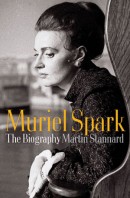 When Martin Stannard’s biography of Muriel Spark was published in the UK last summer, it received mostly positive reviews. The Guardian judged that “Stannard is to be congratulated on producing what will undoubtedly be the standard biography of a writer with perhaps the most distinctive voice — darkly satirical with theological dimensions — in postwar British fiction.” With reservations, the Telegraph concluded, “all in all this is a biography that has been worth the long wait.” And the Independent said, “Stannard is a gifted biographer with a fine turn of phrase. . . . There are a few blind spots . . . but this account will not be surpassed.”
When Martin Stannard’s biography of Muriel Spark was published in the UK last summer, it received mostly positive reviews. The Guardian judged that “Stannard is to be congratulated on producing what will undoubtedly be the standard biography of a writer with perhaps the most distinctive voice — darkly satirical with theological dimensions — in postwar British fiction.” With reservations, the Telegraph concluded, “all in all this is a biography that has been worth the long wait.” And the Independent said, “Stannard is a gifted biographer with a fine turn of phrase. . . . There are a few blind spots . . . but this account will not be surpassed.”
But the first major review of the book upon its U.S. publication this week is a mostly critical take from Dwight Garner at the New York Times:
In a perfect world, a biography of Muriel Spark (1918-2006) would share some of the qualities of her best novels, among them Memento Mori, The Prime of Miss Jean Brodie and The Girls of Slender Means. That is, it would be sinister, comic and ruthlessly slim, a jar that holds a scorpion.
Martin Stannard’s Muriel Spark: The Biography, alas, exists in the real world. Mr. Stannard has delivered instead an ordinary lumpy mattress of a biography, with coils and feathers poking out the sides and a few bedbugs leaping to the floor. Spark rarely wasted a word. Mr. Stannard throws whole armies of them into the breach. . . . Muriel Spark: The Biography has shrewd observations and quickening moments, but waiting for them requires Zen-like patience and is a bit soul-killing, like standing in line at the D.M.V.
Muriel Spark: The Biography by Martin Stannard
by Martin Stannard
Norton, 627 pp., $35.00
Wednesday, April 7th, 2010
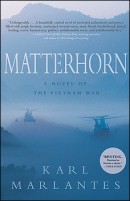 Marlantes, a decorated veteran of the Vietnam War, wrote this novel over the course of 30 years. It follows a company of Marines as they build an outpost on the titular hilltop, abandon it for other duties, and then retake it. Several reviewers of the novel have spent time in the military, or have covered it as journalists. In the New York Times Book Review, Sebastian Junger wrote: “[Marlantes] seems like a man whose life was radically altered by war, and who now wants to pass along the favor. And with a desperate fury, he does. Chapter after chapter, battle after battle, Marlantes pushes you through what may be one of the most profound and devastating novels ever to come out of Vietnam — or any war. It’s not a book so much as a deployment, and you will not return unaltered.” According to Junger, even the book’s hurdles, like “a blizzard of names, ranks and military terms,” enhance it: “That confusion . . . was exactly my experience while covering the United States military as a journalist, and in Matterhorn it struck me as annoying but true.”
Marlantes, a decorated veteran of the Vietnam War, wrote this novel over the course of 30 years. It follows a company of Marines as they build an outpost on the titular hilltop, abandon it for other duties, and then retake it. Several reviewers of the novel have spent time in the military, or have covered it as journalists. In the New York Times Book Review, Sebastian Junger wrote: “[Marlantes] seems like a man whose life was radically altered by war, and who now wants to pass along the favor. And with a desperate fury, he does. Chapter after chapter, battle after battle, Marlantes pushes you through what may be one of the most profound and devastating novels ever to come out of Vietnam — or any war. It’s not a book so much as a deployment, and you will not return unaltered.” According to Junger, even the book’s hurdles, like “a blizzard of names, ranks and military terms,” enhance it: “That confusion . . . was exactly my experience while covering the United States military as a journalist, and in Matterhorn it struck me as annoying but true.”
In the Washington Post, David Masiel, a former Merchant Marine, writes: “Given the long list of stellar works, fiction and nonfiction, to come from the Vietnam experience, one might question what more can be said about it. In some ways Matterhorn isn’t new at all, but it reminds us of the horror of all war by laying waste to romantic notions and napalming the cool factor of video games and ‘Generation Kill.’”
At the Barnes & Noble Review, David Abrams says the book “puts the reader in the thick of combat like few others I’ve read.” But he doesn’t think the novel is perfect:
While Marlantes is skilled at conducting large battle scenes, he sometimes falls short at the level of his sentences. One wishes he would relax enough to trust the reader; instead, he (or his editors) feels the need to define every acronym and military term as they appear in the narrative — despite the fact that there is a 30-page glossary at the end of the novel. . . . But once he hits his stride (and most of the military jargon has been exhaustively defined), Marlantes displays all the confidence of a veteran who knows what he’s talking about.
You can watch Marlantes talk about writing the book here.
Matterhorn by Karl Marlantes
by Karl Marlantes
Atlantic Monthly Press, 592 pp., $24.95
Monday, March 29th, 2010
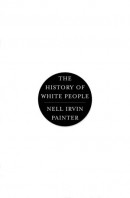 Painter, a professor of American History at Princeton, has written a sprawling book that considers the changing definitions of whiteness from ancient times to the present day. Robert Birnbaum says the book addresses race as “a human contrivance, made malleable by shifting historical circumstances and forces,” and quotes Painter’s preface: “American history offers up a large bounty of commentary on what it means to be non-white. . . . But little attention has been paid to history’s equally confused and flexible discourses on the white races and the old, old slave trade from eastern Europe.”
Painter, a professor of American History at Princeton, has written a sprawling book that considers the changing definitions of whiteness from ancient times to the present day. Robert Birnbaum says the book addresses race as “a human contrivance, made malleable by shifting historical circumstances and forces,” and quotes Painter’s preface: “American history offers up a large bounty of commentary on what it means to be non-white. . . . But little attention has been paid to history’s equally confused and flexible discourses on the white races and the old, old slave trade from eastern Europe.”
Reviewing the book for the New York Times, Linda Gordon writes that Painter
has written an unusual study: an intellectual history, with occasional excursions to examine vernacular usage, for popular audiences. It has much to teach everyone, including whiteness experts, but it is accessible and breezy, its coverage broad and therefore necessarily superficial. . . . But I cannot fault Nell Painter’s choices — omissions to keep a book widely readable. Often, scholarly interpretation is transmitted through textbooks that oversimplify and even bore their readers with vague generalities. Far better for a large audience to learn about whiteness from a distinguished scholar in an insightful and lively exposition.
In the San Francisco Chronicle, Paul Devlin agrees:
[The History of White People] is a scholarly, non-polemical masterpiece of broad historical synthesis, combining political, scientific, economic and cultural history. . . . [Painter] ranges far and wide with authority. . . . Trying to cover all bases, [she] presents detailed readings of a wide array of scientific and literary texts, offering deeply researched context and making connections with a clear and engaging style.
The History of White People by Nell Irvin Painter
by Nell Irvin Painter
Norton, 496 pp., $27.95
Tuesday, March 23rd, 2010
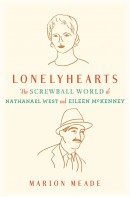 When they were killed together in a car accident in December 1940, Nathanael West and Eileen McKenney had been married for eight months. West’s novels, The Day of the Locust
When they were killed together in a car accident in December 1940, Nathanael West and Eileen McKenney had been married for eight months. West’s novels, The Day of the Locust and Miss Lonelyhearts
and Miss Lonelyhearts would bring him great posthumous fame, but at the time McKenney was the more renowned half of the couple. Her sister Ruth had written stories for The New Yorker that detailed her and Eileen’s adventures living together in Greenwich Village. Marion Meade’s dual biography has to overcome the couple’s brief time together (West and McKenney don’t meet until page 270 of 314) and some of West’s less sympathetic characteristics. In the Wall Street Journal, Molly Haskell says, “It’s a mark of the man’s peculiar charm, and of Ms. Meade’s dispassionate perspective, that we come to love West’s eccentricities and forgive his unattractive qualities.”
would bring him great posthumous fame, but at the time McKenney was the more renowned half of the couple. Her sister Ruth had written stories for The New Yorker that detailed her and Eileen’s adventures living together in Greenwich Village. Marion Meade’s dual biography has to overcome the couple’s brief time together (West and McKenney don’t meet until page 270 of 314) and some of West’s less sympathetic characteristics. In the Wall Street Journal, Molly Haskell says, “It’s a mark of the man’s peculiar charm, and of Ms. Meade’s dispassionate perspective, that we come to love West’s eccentricities and forgive his unattractive qualities.”
In the New York Times, Dwight Garner is interested in the tale but defeated by Meade’s telling. “The first thing worth saying about Lonelyhearts,” he writes, “is that it tells two quite interesting parallel stories, each packed with piquant details. . . . The bad news about Lonelyhearts is that Ms. Meade’s own unsubtle voice will make you wince on almost every page. To hear her tell this story is like listening to someone play Aaron Copland on a kazoo. Katharine White, the legendary New Yorker fiction editor, is described as a ‘major-league prune.’ The New Yorker itself is noted for its ‘yuks.’ Horatio Alger’s prose is ‘vomited into the national psyche.’ . . . This book’s tone — I kept waiting for Ms. Meade, like a gum-snapping waitress in a diner, to start calling the reader ‘Hon’ — isn’t improved by her insistence on referring to people by their nicknames.”
At Salon, Laura Miller forgives the “retro-slangy voice.” In fact, she writes, “(I kinda like it myself.) But what makes her book fascinating is more sociological and historical: It opens a window onto the lives of writers in 1930s America as they struggled with anxieties, pretensions, temptations and myths that confound our culture to this day.” In the Washington Post, Jonathan Yardley calls the book “peculiar,” partly because it can’t help but be imbalanced: “West already has been the subject of a rather massive biography by Jay Martin, and the vultures of academe have picked his carcass to pieces. Presumably the device that Meade fastened upon to distinguish her book from the others was to bring McKenney into the story as, in effect, an equal partner. But West remains the dominant figure for the obvious reasons: He accomplished more, he had more famous and interesting friends, he had a longer life.”
Lonelyhearts: The Screwball World of Nathanael West and Eileen McKenney by Marion Meade
by Marion Meade
Houghton Mifflin Harcourt, 416 pp., $28.00
Wednesday, March 17th, 2010
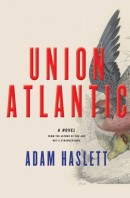 Haslett’s first novel—his 2002 story collection, You Are Not a Stranger Here
Haslett’s first novel—his 2002 story collection, You Are Not a Stranger Here , was a finalist for the Pulitzer Prize and the National Book Award—has been getting some of the best reviews of the new year. It follows a young banker named Doug Fanning as he builds a McMansion and helps the titular bank make some ambitious, risky moves. His neighbor, Charlotte Graves, is a retired history teacher who wants to boot Doug off the land. Charlotte, who believes her two dogs are speaking to her in the voices of Cotton Mather and Malcolm X, begins tutoring a high school senior named Nate. Oh, and Charlotte’s brother is the head of the New York Federal Reserve.
, was a finalist for the Pulitzer Prize and the National Book Award—has been getting some of the best reviews of the new year. It follows a young banker named Doug Fanning as he builds a McMansion and helps the titular bank make some ambitious, risky moves. His neighbor, Charlotte Graves, is a retired history teacher who wants to boot Doug off the land. Charlotte, who believes her two dogs are speaking to her in the voices of Cotton Mather and Malcolm X, begins tutoring a high school senior named Nate. Oh, and Charlotte’s brother is the head of the New York Federal Reserve.
In the Washington Post, Ron Charles writes: “Adam Haslett is no John Steinbeck, but he may be our F. Scott Fitzgerald, an author capable of memorializing our crash in all its personal cost and lurid beauty. His first novel, Union Atlantic, is a strange, elegant story that illuminates the financial and moral calamity of the young 21st century.” And in the New York Times, Liesl Schillinger says, “The eerie overlap of Haslett’s narrative with current events in the American economy gives Union Atlantic unusual impact. This timely novel demonstrates not only how the financial crisis happened but why—by documenting the intersection of big, blunt historical forces with tiny, intricate, cumulatively powerful personal impulses. Businesses become too big to fail, Haslett suggests, because individuals fail one another, in a snowball effect.”
Haslett is a graceful writer (a “gorgeous minimalist” in Charles’ words), but I got stuck about halfway through the novel because of details, not style, and I’m unsure about whether I’ll try to get unstuck. The idea of the dog voices strikes me as supremely silly, Charlotte’s speeches are obvious in their didacticism, and Doug is a bland container for bigger ideas. Scott Indrisek, writing for Bookforum, gets closest to explaining my reaction to the book: “Fanning’s downfall would have been more of a tragedy if the author had succeeded in painting him as anything more than a cipher. . . . Union Atlantic aims to be the Important Social Novel of 2010; instead, it’s an entertaining and topical melodrama. To its credit, the book is a fair snapshot of our current economic and geopolitical impasse: loud, contradictory, yet oddly static.”
Union Atlantic by Adam Haslett
by Adam Haslett
Nan A. Talese, 320 pp., $26.00
Friday, March 12th, 2010
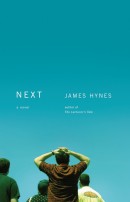 Next follows a few hours in the life of Kevin Quinn, a middle-aged academic traveling from Ann Arbor to Austin for a job interview. Recent terrorist attacks in Europe have everyone on edge, and Quinn worries about his possible fate while reminiscing about a lost love. Publishers Weekly called Hynes’ fifth novel “funny, surprising, and sobering. . . . The final 50 pages are unlike anything in the recent literature of our response to terrorism—a tour de force of people ennobled in the face of random horror.” Those final pages get a lot of play in the book’s reviews, though critics aren’t giving anything away. In a New York Times rave, Janet Maslin writes, “Mr. Hynes encrypts so much foreshadowing into Next that there might as well be none at all. Little jabs are everywhere.” It all leads to “an ending that beggars description. . . . Finally this book arrives at a resolution that makes breathtakingly perfect sense.”
Next follows a few hours in the life of Kevin Quinn, a middle-aged academic traveling from Ann Arbor to Austin for a job interview. Recent terrorist attacks in Europe have everyone on edge, and Quinn worries about his possible fate while reminiscing about a lost love. Publishers Weekly called Hynes’ fifth novel “funny, surprising, and sobering. . . . The final 50 pages are unlike anything in the recent literature of our response to terrorism—a tour de force of people ennobled in the face of random horror.” Those final pages get a lot of play in the book’s reviews, though critics aren’t giving anything away. In a New York Times rave, Janet Maslin writes, “Mr. Hynes encrypts so much foreshadowing into Next that there might as well be none at all. Little jabs are everywhere.” It all leads to “an ending that beggars description. . . . Finally this book arrives at a resolution that makes breathtakingly perfect sense.”
At Bookslut, Michael Schaub, who gave Next an enthusiastic full review, is still feeling the aftershocks: “I’ve been recommending James Hynes’ Next to anyone who will listen—neighbors, the clerks at the Plaid Pantry where I buy cigarettes, the audience of The Ed Forman Show (long story), my dogs, police officers who stop and ask me questions when they see me talking to my dogs.”
Next by James Hynes
by James Hynes
Reagan Arthur Books, 320 pp., $23.99
Thursday, March 4th, 2010
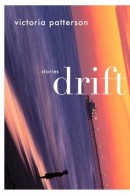 Reviewed by Adam Gallari
Reviewed by Adam Gallari
Her debut collection, Drift, earned Victoria Patterson a place as a finalist for this year’s Story Prize (won by Daniyal Mueenuddin). The book is a series of tales set against the posh seaside backdrop of Newport Beach, California. Patterson’s ostensible goal is to pull back the façade of the “SoCal” readers think they know and draw attention to what really lurks beneath the veneer.
Drift’s characters are never secure, always prone to be dismissed for newer, shinier, chicer versions of themselves. And though Patterson occasionally offers a male voice— the most interesting being John Wayne, a burnt-out skateboarder rendered nearly mute by a drug overdose— she seems primarily concerned with what constitutes female friendship in this affluent hamlet. These women are confused and tragic figures, aware of their sexual powers and their capabilities, yet simultaneously powerless, beholden to husbands and lovers capable of abandoning them at any time. Patterson too often relies on the trope of the checkered past or the desire to be loved as the rationale behind the excessive and self-destructive promiscuity of some of her characters. But she also effectively shows the fate of women trapped, even in a post-feminist world, as symbols, continually refashioned by plastic surgeons to keep their aging bodies competitive with those of the daughters they and their friends have produced.
The perspectives in Drift are constantly shifting. Rosie, a troubled but engaging young woman caught between a born-again Christian father and a gold-digging mother, emerges as the book’s central protagonist, nearly every story returning to her in some way. The structure of the book is less a series of independent narratives than related puzzle pieces that form what the modern story collection often does, a loosely contained novel.
Patterson’s prose can be clean and appealingly straightforward, and she’s at her best within the troubled minds of a character, channeling a distraught consciousness trying to make sense of the world. But there are too many moments in which her writing veers toward the confessional and the melodramatic. Still, though it’s uneven, Drift is an ambitious first effort and marks Patterson as a writer to watch.
Drift by Victoria Patterson
by Victoria Patterson
Mariner Books, 240 pp., $12.95
Thursday, March 4th, 2010
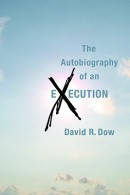 This memoir by Dow, founder of the Texas Innocence Network, details his time as an advocate for those on death row. In the Los Angeles Times, Art Winslow says the book is written in a “relatively spare, direct but distinctly literary style” and that “Dow’s voice throughout is one of modulated anger: He seethes within boundaries.”
This memoir by Dow, founder of the Texas Innocence Network, details his time as an advocate for those on death row. In the Los Angeles Times, Art Winslow says the book is written in a “relatively spare, direct but distinctly literary style” and that “Dow’s voice throughout is one of modulated anger: He seethes within boundaries.”
In the New York Times, Dahlia Lithwick addresses the more personal strands of the book: “Readers who don’t care about his son’s T-ball practices or his wife’s dance classes may find this background distracting, but for Dow his family is a lifeline back from the death chamber.” She also points out, as have all the reviewers I’ve read, that the “demands of attorney-client confidentiality” have ensured the book is “less an autobiography of an execution than a powerful collage of the life of a death penalty lawyer. . . . [H]aving created a brilliant, heart-rending book that can’t be properly fact-checked, Dow almost seems to have joined the ranks of people who will privilege emotion over detail, and narrative over precision.”
In the Christian Science Monitor, Steve Weinberg says he trusts Dow on the facts, in part because they corroborate what Weinberg himself has learned in studying wrongful convictions. His overall take: “Dow is not the first anti-death penalty advocate to criticize the criminal justice system in print, and he probably will not be the last. But his book is especially worthy, whatever a reader’s opinion about the morality of the death penalty. Dow’s candor seems so absolute that readers on both sides of the debate can gain insight into the thought process of an experienced advocate.”
A negative review is turned in by Kyle Smith of the New York Post, but its sour tone and clear lack of interest in discussing the real issues at hand leave me wishing for a reviewer to present the other side with some logic. And class.
GQ published an excerpt, and Dow discussed the book with Leonard Lopate.
The Autobiography of an Execution by David R. Dow
by David R. Dow
Twelve, 288 pp., $24.99
Friday, February 26th, 2010
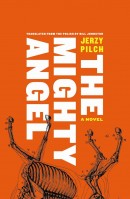 In Jerzy Pilch’s novel, beautifully translated from the Polish by Bill Johnston, a writer named Jerzy has been to the “alco ward” 18 times. Each time, he has left with his alcoholism firmly intact. The novel (which takes its name from a bar frequented by Jerzy, as well as a quote from Revelation cited in one chapter: “And I saw another mighty angel come down from heaven, clothed with a cloud . . .”) is a lively, poignant, and often funny examination of a central question: “I’m aware, I really am fully aware that it’s impossible, in my case especially it’s impossible, to live a long and happy life when you drink. But how can you live a long and happy life if you don’t drink?”
In Jerzy Pilch’s novel, beautifully translated from the Polish by Bill Johnston, a writer named Jerzy has been to the “alco ward” 18 times. Each time, he has left with his alcoholism firmly intact. The novel (which takes its name from a bar frequented by Jerzy, as well as a quote from Revelation cited in one chapter: “And I saw another mighty angel come down from heaven, clothed with a cloud . . .”) is a lively, poignant, and often funny examination of a central question: “I’m aware, I really am fully aware that it’s impossible, in my case especially it’s impossible, to live a long and happy life when you drink. But how can you live a long and happy life if you don’t drink?”
Jerzy occasionally stops to chronicle the experiences of his ward mates, a group worthy of One Flew Over the Cuckoo’s Nest, with colorful pseudonyms like The Most Wanted Terrorist in the World, the Hero of Socialist Labor, and the Sugar King. But the majority of the action is Jerzy’s internal struggle with what it means to drink, to write, and to write about drinking.
Alcoholism, in The Mighty Angel, is an existential strategy first, aimed at coping with the fact that “life in general is a life sentence,” the world itself is “one big illness,” and “The waking world is one immense reason to drink.” If those sentiments are grave, much of what Jerzy writes is lighter: “I have long observed that a distinct asymmetry in the male physique enhances the languishing receptivity of women. The mystery of this aberration cannot be unlocked, however, without drunken hypotheses, and for the moment I set it aside.” Pondering the computer that defeated Garry Kasparov at chess, he thinks: “until they invent the computer that can drink more than a person, humankind has no need to feel that its essence is under threat.”
Love threatens to save Jerzy in the end, but whether or not this salvation is realistic (or this love is even real) remains open to interpretation; appropriate in a book that is drawn to difficult questions, not easy answers.
The Mighty Angel by Jerzy Pilch
by Jerzy Pilch
Open Letter, 155 pp., $15.95
Monday, February 22nd, 2010
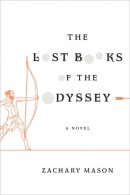 At Slate, John Swansburg writes:
At Slate, John Swansburg writes:
There are less hubristic ways to start a career as a novelist than by retelling the story of The Odyssey. For one thing, the original was pretty good. For another, the story has been retold before—by the likes of Alfred Lord Tennyson, James Joyce, and Fritz Lang, to name a few. Yet in The Lost Books of the Odyssey, Zachary Mason has achieved something remarkable. He’s written a first novel that is not just vibrantly original but also an insightful commentary on Homer’s epic and its lasting hold on our imagination.
The New York Times gave the book its double-barreled review treatment (and threw in a profile of the author for good measure). Adam Mansbach says the book could “plausibly have been excavated from the files of Jorge Luis Borges or the early drafts of Italo Calvino’s Invisible Cities” and that “[e]ven when he falters . . . Mason’s imagination soars and his language delights.” Michiko Kakutani called it a “dazzling debut,” and wrote: “This is a book that not only addresses the themes of Homer’s classic—the dangers of pride, the protean nature of identity, the tryst between fate and free will—but also poses new questions to the reader about art and originality and the nature of storytelling.”
Mason’s novel made the rare move from independent press to republished by a major house, and Steve Donoghue reviewed it back in 2007, when it was released by Starcherone Books. He raved that “Mason’s command of English prose is soaringly intelligent, and his ability to evoke the strange and the wondrous is as hard and swift as a poet’s.” His one, significant qualm was with an “incredibly distracting” gimmick in which Mason “regularly [draws] attention to the scaffolding of the story.” But even this distraction, according to Donoghue, “does not scupper the book, and for that miraculous fact Mason has only his own linguistic virtuosity to thank. His writing is so spellbinding, so fluid and suggestive, that any irritation [. . .] is washed away time and again by the sheer symphony of his invention.”
The Lost Books of the Odyssey by Zachary Mason
by Zachary Mason
Farrar, Straus and Giroux, 228 pp., $24.00
Friday, February 19th, 2010
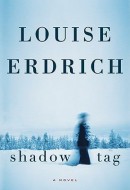 Louise Erdrich’s 13th novel is being called a change of pace, and a good one. Gil, a painter, and Irene, a historian, are married with three children. They each have Native American ancestry, but the narrative here is a tight domestic drama, not the multi-generational sagas Erdrich fans are used to. The couple is miserable, and in hopes of getting Gil to leave, Irene begins a fake diary in which she chronicles manufactured infidelities. In the Washington Post, Ron Charles calls the novel “a tense little masterpiece of marital strife” that features “some of Erdrich’s most beautiful and urgent writing.” And though the story invites speculation about real life because of its similarities to Erdrich’s troubled marriage to the writer Michael Dorris, who committed suicide in 1997, Charles writes: “Erdrich has done what so many writers can’t or won’t do in this age of self-exposure: transform her own wrenching experience into a captivating work of fiction that says far more about the universal tragedy of spoiled love than it reveals about her private life.”
Louise Erdrich’s 13th novel is being called a change of pace, and a good one. Gil, a painter, and Irene, a historian, are married with three children. They each have Native American ancestry, but the narrative here is a tight domestic drama, not the multi-generational sagas Erdrich fans are used to. The couple is miserable, and in hopes of getting Gil to leave, Irene begins a fake diary in which she chronicles manufactured infidelities. In the Washington Post, Ron Charles calls the novel “a tense little masterpiece of marital strife” that features “some of Erdrich’s most beautiful and urgent writing.” And though the story invites speculation about real life because of its similarities to Erdrich’s troubled marriage to the writer Michael Dorris, who committed suicide in 1997, Charles writes: “Erdrich has done what so many writers can’t or won’t do in this age of self-exposure: transform her own wrenching experience into a captivating work of fiction that says far more about the universal tragedy of spoiled love than it reveals about her private life.”
In the New York Times, Leah Hager Cohen says, “[I]n places, Shadow Tag seems more like notes for a novel than fully realized fiction. . . . Elsewhere, though, Erdrich’s unbridled urgency yields startlingly original phrasing as well as flashes of blinding lucidity.” In the Boston Globe, Perrin Ireland says the novel’s pacing “nudges Erdrich’s lyricism into thriller territory. While the writing is fiercely disciplined, with a poet’s polish, every line is unpredictable.”
Shadow Tag by Louise Erdrich
by Louise Erdrich
Harper, 272 pp., $25.99
Tuesday, February 16th, 2010
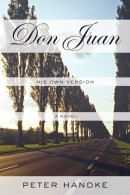 In Handke’s slim novel, the famous lover hops a wall, fleeing from an angry couple, and begins recounting his life to an innkeeper. In the Los Angeles Times, Natasha Randall notes that more than 1,500 versions of Don Juan’s story have been written, and that most of these “tend to damn Don Juan variously—and to damn the women who succumbed to or partook in the seduction too. But Handke is defiant of these versions, and his Don Juan isn’t corralled into any tidy deliverance.” Instead, Handke “show[s] them up with his clean, broad narration, which refuses to herd a reader toward conclusion. Handke’s text is anti-reductive.”
In Handke’s slim novel, the famous lover hops a wall, fleeing from an angry couple, and begins recounting his life to an innkeeper. In the Los Angeles Times, Natasha Randall notes that more than 1,500 versions of Don Juan’s story have been written, and that most of these “tend to damn Don Juan variously—and to damn the women who succumbed to or partook in the seduction too. But Handke is defiant of these versions, and his Don Juan isn’t corralled into any tidy deliverance.” Instead, Handke “show[s] them up with his clean, broad narration, which refuses to herd a reader toward conclusion. Handke’s text is anti-reductive.”
In the New York Times, Joel Agee writes: “Caveat emptor: this book is not about sex. The Don Juan of legend, opera and literature was a ruthless libertine whose servant kept count of his thousands of conquests. Now the true Don Juan has come to tell us that Mozart, Molière and all his other interpreters had it wrong. He is an orphaned soul—“orphaned,” we learn, by the death of a child, or, alternatively, a lover—and sorrow, not desire, is his motive force.” Yet, despite calling the book a “whimsical tour de force,” Agee concludes that “It doesn’t quite work.” For all of the intellectual pleasures offered by Handke, Agee misses the “brilliant, joyful virility” of earlier Don Juans.
Don Juan: His Own Version by Peter Handke
by Peter Handke
Farrar, Straus and Giroux, 112 pp., $22.00
Monday, February 8th, 2010
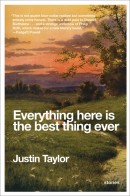 Justin Taylor’s debut story collection has been getting positive reviews—with caveats, but positive. Todd Pruzan, in the New York Times Book Review, offers the least qualified praise, saying, “This spare, sharp book documents a deep authority on the unavoidable confusion of being young, disaffected and human” and that Taylor’s voice is one “that readers—and writers, too—might be seeking out for decades to come.” In Bookforum, Eryn Loeb writes that, “Taylor’s heroes—mostly males ranging from twitchy kids to restless thirty-somethings—are reliably uncomfortable in their own skins, embracing risk in an attempt to salvage some sense of themselves,” and that “[a] subtle misanthropy pervades” the collection. The Oxford American compares the book’s dark humor to the very good company of Mary Gaitskill’s Bad Behavior
Justin Taylor’s debut story collection has been getting positive reviews—with caveats, but positive. Todd Pruzan, in the New York Times Book Review, offers the least qualified praise, saying, “This spare, sharp book documents a deep authority on the unavoidable confusion of being young, disaffected and human” and that Taylor’s voice is one “that readers—and writers, too—might be seeking out for decades to come.” In Bookforum, Eryn Loeb writes that, “Taylor’s heroes—mostly males ranging from twitchy kids to restless thirty-somethings—are reliably uncomfortable in their own skins, embracing risk in an attempt to salvage some sense of themselves,” and that “[a] subtle misanthropy pervades” the collection. The Oxford American compares the book’s dark humor to the very good company of Mary Gaitskill’s Bad Behavior and Denis Johnson’s Jesus’ Son
and Denis Johnson’s Jesus’ Son . The magazine warns: “Beware: The nontraditional sexual relationship is a theme in Taylor’s work and deliciously unusual conflicts appear.” Taylor’s fondness for Donald Barthelme has been mentioned in reviews, so perhaps it’s unsurprising that the magazine also says, “Occasionally, Taylor’s ambitious formal experiments detract from his hypnotic plots and sloppily charming characters.” In Time Out New York, Second Pass contributor Jessica Ferri says that “Taylor captures the suffocating boredom of small-town life perfectly, pinpointing how a lack of culture combined with a disappointing family situation can become a recipe for bad behavior,” and that he “displays a gift for illuminating the connections between the mundane and the grotesque.”
. The magazine warns: “Beware: The nontraditional sexual relationship is a theme in Taylor’s work and deliciously unusual conflicts appear.” Taylor’s fondness for Donald Barthelme has been mentioned in reviews, so perhaps it’s unsurprising that the magazine also says, “Occasionally, Taylor’s ambitious formal experiments detract from his hypnotic plots and sloppily charming characters.” In Time Out New York, Second Pass contributor Jessica Ferri says that “Taylor captures the suffocating boredom of small-town life perfectly, pinpointing how a lack of culture combined with a disappointing family situation can become a recipe for bad behavior,” and that he “displays a gift for illuminating the connections between the mundane and the grotesque.”
Everything Here Is the Best Thing Ever by Justin Taylor
by Justin Taylor
Harper Perennial, 208 pp., $13.99
Friday, February 5th, 2010
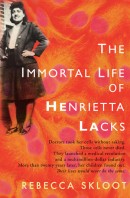 In the 1950s, Henrietta Lacks had cells taken from her cancerous cervix without her knowing. Those cells turned out to be the first to ever grow in culture, and there are “trillions more of [Lacks'] cells growing in laboratories now than there ever were in her body.” Rebecca Skloot’s account of Lacks’ life, as a poor tobacco farmer in Virginia, and her ensuing but anonymous “fame” in the laboratory (her cells known as “HeLa” cells) was 10 years in the making. It’s been getting enough media attention to convince one that maybe books aren’t dying. Any bad karma it may have seems to have landed squarely on its homely cover design. Otherwise, this is one blessed book. The Boston Globe starts us out nice and easy: “a well-written, carefully-researched, complex saga of medical research, bioethics, and race in America.” Jerry Coyne raises the volume, calling the book “a modern classic of science writing.” Add the New York Times and you have a deafening roar: “[O]ne of the most graceful and moving nonfiction books I’ve read in a very long time. . . . floods over you like a narrative dam break . . . [Skloot] writes about Henrietta Lacks and her impact on modern medicine from almost every conceivable angle and manages to make all of them fascinating.” And then science blogger “Dr. Isis” just loses it: “This is, without a doubt, the single best piece of non-fiction I have ever read. It is one of the most important stories of the last 100 years and should be required reading for every scientist and physician-in-training.”
In the 1950s, Henrietta Lacks had cells taken from her cancerous cervix without her knowing. Those cells turned out to be the first to ever grow in culture, and there are “trillions more of [Lacks'] cells growing in laboratories now than there ever were in her body.” Rebecca Skloot’s account of Lacks’ life, as a poor tobacco farmer in Virginia, and her ensuing but anonymous “fame” in the laboratory (her cells known as “HeLa” cells) was 10 years in the making. It’s been getting enough media attention to convince one that maybe books aren’t dying. Any bad karma it may have seems to have landed squarely on its homely cover design. Otherwise, this is one blessed book. The Boston Globe starts us out nice and easy: “a well-written, carefully-researched, complex saga of medical research, bioethics, and race in America.” Jerry Coyne raises the volume, calling the book “a modern classic of science writing.” Add the New York Times and you have a deafening roar: “[O]ne of the most graceful and moving nonfiction books I’ve read in a very long time. . . . floods over you like a narrative dam break . . . [Skloot] writes about Henrietta Lacks and her impact on modern medicine from almost every conceivable angle and manages to make all of them fascinating.” And then science blogger “Dr. Isis” just loses it: “This is, without a doubt, the single best piece of non-fiction I have ever read. It is one of the most important stories of the last 100 years and should be required reading for every scientist and physician-in-training.”
The Immortal Life of Henrietta Lacks by Rebecca Skloot
by Rebecca Skloot
Crown, 384 pp., $26.00
Tuesday, January 12th, 2010
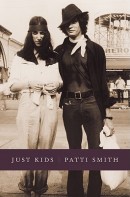 Punk pioneer Smith’s memoir recounts her creative and romantic relationship with the controversial photographer Robert Mapplethorpe in 1960s and ’70s New York. Laura Miller writes that, “Although Just Kids is Smith’s tribute to Mapplethorpe, she’s the more arresting character of the pair” and that this is “a book utterly lacking in irony or sophisticated cynicism.” In a profile of Smith for New York, Vanessa Grigoriadis calls Just Kids “a classic, a romance about becoming an artist in the city, written in a spare, simple style of boyhood memoirs like Frank Conroy’s Stop-Time.”
Punk pioneer Smith’s memoir recounts her creative and romantic relationship with the controversial photographer Robert Mapplethorpe in 1960s and ’70s New York. Laura Miller writes that, “Although Just Kids is Smith’s tribute to Mapplethorpe, she’s the more arresting character of the pair” and that this is “a book utterly lacking in irony or sophisticated cynicism.” In a profile of Smith for New York, Vanessa Grigoriadis calls Just Kids “a classic, a romance about becoming an artist in the city, written in a spare, simple style of boyhood memoirs like Frank Conroy’s Stop-Time.”
In Time Out New York, the wonderfully named Raven Snook says that “the two budding artists come off as incredibly creative and naive geeks who hit the Big Apple in the late ’60s” and that in addition to its other strengths, “Just Kids is also chock-full of amazing anecdotes starring the era’s glitterati—Andy Warhol and the Factory divas, William Burroughs, Jimi Hendrix, Sam Shepard, Janis Joplin, Allen Ginsberg. In the end, it’s not just an ode to Mapplethorpe, but a love letter to New York City’s ’70s art scene itself.” Naming the book one of the best of the month at Amazon, Tom Nissley writes that it’s “tender and artful, open-eyed but surprisingly decorous, with the oracular style familiar from her anthems like ‘Because the Night,’ ‘Gloria,’ and ‘Dancing Barefoot’ balanced by her powers of observation and memory for everyday details like the price of automat sandwiches and the shabby, welcoming fellow bohemians of the Chelsea Hotel, among whose ranks these baby Rimbauds found their way.”
Rolling Stone has an excerpt from the book.
Just Kids by Patti Smith
by Patti Smith
Ecco, 304 pp., $27.00
Tuesday, January 12th, 2010
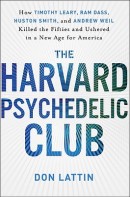 Dwight Garner calls Lattin’s new book a “rollicking if lightweight group biography” about the crossed paths of Timothy Leary, Ram Dass, Huston Smith, and Andrew Weil at Harvard in the 1960s and the birth of the New Age movement. Alterna-guru Weil was a student at the time (his undergraduate thesis was “The Use of Nutmeg as a Psychotropic Agent”) and the rest were faculty. Garner says that Lattin shows how “[a] version of the 1960s was being invented, one dazzling trip at a time,” and then, after the friendships inevitably fizzled, “tracks all four men as they go their separate ways, trailing stardust and grievances.”
Dwight Garner calls Lattin’s new book a “rollicking if lightweight group biography” about the crossed paths of Timothy Leary, Ram Dass, Huston Smith, and Andrew Weil at Harvard in the 1960s and the birth of the New Age movement. Alterna-guru Weil was a student at the time (his undergraduate thesis was “The Use of Nutmeg as a Psychotropic Agent”) and the rest were faculty. Garner says that Lattin shows how “[a] version of the 1960s was being invented, one dazzling trip at a time,” and then, after the friendships inevitably fizzled, “tracks all four men as they go their separate ways, trailing stardust and grievances.”
In the San Francisco Chronicle, Ari Goldman writes, “Many of the stories in this book have been told elsewhere, but Lattin tells them with new energy and weaves them together to create a satisfying narrative that re-creates and explains the era.” Garner, more critical of the book’s prose and plotting, still concludes: “This slim book has more than its share of faults. [. . .] I’d be lying, though, if I said I didn’t enjoy just about every page.”
The Daily Beast has posted an excerpt from the book.
The Harvard Psychedelic Club: How Timothy Leary, Ram Dass, Huston Smith, and Andrew Weil Killed the Fifties and Ushered in a New Age for America by Don Lattin
by Don Lattin
HarperOne, 272 pp., $24.99
Tuesday, January 5th, 2010
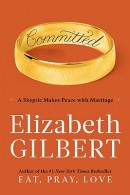 Committed is Gilbert’s follow-up to Eat, Pray, Love, a blockbuster memoir (Julia Roberts will star in the movie) whose “bestseller ranking is measured in years, not weeks.” In that book, Gilbert got over a painful divorce by traveling around the world, during which time she met and fell in love with a Brazilian named Felipe. In Committed, the couple are forced to marry if they are going to be allowed to live in the U.S. Both of them have emotional scars from previous relationships, and hope to overcome hers, Gilbert researches the history and meaning of marriage. Critics, like Amy Reiter at the Barnes & Noble Review, seem unanimous in saying that the new book suffers in comparison to the previous smash: “Eat, Pray, Love was an exploration of the heart. Committed, Gilbert’s attempt to think marriage through, is all head. It lacks, to a great degree, the warmth and intimacy readers have come to expect from this writer.” Coralie Carlson at The Huffington Post says that “[w]hile most people can relate to a story of recovering from heartache, it’s hard to have much empathy for a woman who finds herself forced to marry her Brazilian lover, who is, by all accounts, the man of her dreams.”
Committed is Gilbert’s follow-up to Eat, Pray, Love, a blockbuster memoir (Julia Roberts will star in the movie) whose “bestseller ranking is measured in years, not weeks.” In that book, Gilbert got over a painful divorce by traveling around the world, during which time she met and fell in love with a Brazilian named Felipe. In Committed, the couple are forced to marry if they are going to be allowed to live in the U.S. Both of them have emotional scars from previous relationships, and hope to overcome hers, Gilbert researches the history and meaning of marriage. Critics, like Amy Reiter at the Barnes & Noble Review, seem unanimous in saying that the new book suffers in comparison to the previous smash: “Eat, Pray, Love was an exploration of the heart. Committed, Gilbert’s attempt to think marriage through, is all head. It lacks, to a great degree, the warmth and intimacy readers have come to expect from this writer.” Coralie Carlson at The Huffington Post says that “[w]hile most people can relate to a story of recovering from heartache, it’s hard to have much empathy for a woman who finds herself forced to marry her Brazilian lover, who is, by all accounts, the man of her dreams.”
In The New Yorker, Ariel Levy writes:
Committed is an unfurling of Gilbert’s profound anxiety about reentering a legally binding arrangement that she does not really believe in. All this ambivalence, expressed in her high-drama prose, can be a lot to handle. (One generally doesn’t indulge another person’s emotional processing at this length unless the jabbering is likely to conclude with sex.) Ultimately, Gilbert is clear about what she, like most people, wants: everything. [. . .] But we can’t have it. Gilbert understands this, yet she tries to convince herself and her readers that she has found a loophole. She tells herself a familiar story, that her marriage will be different. And she is, of course, right—everyone’s marriage is different. But everyone’s marriage is a compromise.
Committed: A Skeptic Makes Peace with Marriage by Elizabeth Gilbert
by Elizabeth Gilbert
Viking, 304 pp., $26.95
Monday, December 21st, 2009
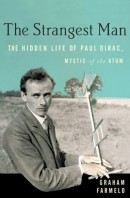 Speaking of enigmatic physicists (see entry immediately below), Paul Dirac, one of the 20th century’s greatest scientists, possessed oddness that matched his brilliance. (Among many other accomplishments, he predicted the existence of antimatter.) Graham Farmelo’s widely praised new biography takes its title from a Niels Bohr quote: “Dirac is the strangest man who ever visited my institute.” In her review of the book for the New York Times, Louisa Gilder didn’t waste any time, beginning: “This biography is a gift. It is both wonderfully written (certainly not a given in the category Accessible Biographies of Mathematical Physicists) and a thought-provoking meditation on human achievement, limitations and the relations between the two.”
Speaking of enigmatic physicists (see entry immediately below), Paul Dirac, one of the 20th century’s greatest scientists, possessed oddness that matched his brilliance. (Among many other accomplishments, he predicted the existence of antimatter.) Graham Farmelo’s widely praised new biography takes its title from a Niels Bohr quote: “Dirac is the strangest man who ever visited my institute.” In her review of the book for the New York Times, Louisa Gilder didn’t waste any time, beginning: “This biography is a gift. It is both wonderfully written (certainly not a given in the category Accessible Biographies of Mathematical Physicists) and a thought-provoking meditation on human achievement, limitations and the relations between the two.”
When the book was published in the UK earlier this year, Tim Radford wrote that Dirac, “a silent, solemn, young beanpole . . . sounds like an unlikely candidate for a biography, let alone a ‘hidden life.’ And yet [The Strangest Man] races along. . . . This is a rich book: it pinpoints the moment, the milieu, the excitement of discovery and the mystery of matter, and it provides an alternative social history of the 20th century as well. And all of this is held together by a figure simultaneously touching and mysterious.”
Peter Woit finds the bio’s last section, about Dirac and his possible feelings about string theory, “seriously misguided.” But Woit concludes: “Ignoring the last few pages, Farmelo’s book is quite wonderful, by far the best thing written about Dirac as a person and scientist, and it’s likely to remain so for quite a while.”
The Strangest Man: The Hidden Life of Paul Dirac, Mystic of the Atom by Graham Farmelo
by Graham Farmelo
Basic Books, 560 pp., $29.95
Monday, December 21st, 2009
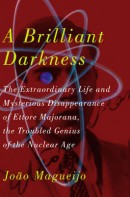 In naming João Magueijo’s A Brilliant Darkness one of the best science books of 2009, Brendan Borrell says, “[Physicist Ettore] Majorana’s story has been told many times before in Italian, but this entertaining and humorous book marks the first comprehensive treatment in English.”
In naming João Magueijo’s A Brilliant Darkness one of the best science books of 2009, Brendan Borrell says, “[Physicist Ettore] Majorana’s story has been told many times before in Italian, but this entertaining and humorous book marks the first comprehensive treatment in English.”
According to Seed Magazine, which also named the book one of the year’s best, “On March 26, 1938, the Italian physicist [Ettore Majorana] disappeared with his passport and $70,000 in hand, leaving behind a series of bizarre suicide notes. He boarded a ferry, apparently to drown himself, but the next day, he wrote a friend, ‘The sea has rejected me…tomorrow I’ll return.’ He was never heard from again.”
At his blog Not Even Wrong, Peter Woit highly recommends the book, but says it shouldn’t be approached too seriously:
While it contains a lot of factual information, much of which I was unaware of, it’s probably best to think of it like the works of Hunter S. Thompson. Not a good place to go for authoritatively accurate information about, e.g., Las Vegas or the 1972 U.S. Presidential campaign, but a highly personal investigation that manages to get to the heart of the matter, finding emotional if not literal truth.
A Brilliant Darkness: The Extraordinary Life and Mysterious Disappearance of Ettore Majorana, the Troubled Genius of the Nuclear Age by João Magueijo
by João Magueijo
Basic Books, 304 pp., $27.50
Wednesday, December 9th, 2009
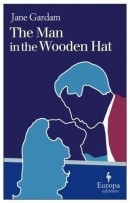 Jane Gardam, 81, has had a long and successful literary career, full of prizes, in the UK, but she only came to wide attention in the U.S. with the 2006 publication of Old Filth
Jane Gardam, 81, has had a long and successful literary career, full of prizes, in the UK, but she only came to wide attention in the U.S. with the 2006 publication of Old Filth , a novel about Sir Edward Feathers, a retired British judge whose professional success took place in the Far East. (His nickname, Filth, is an acronym for “Failed in London Try Hong Kong.”) The Man in the Wooden Hat
, a novel about Sir Edward Feathers, a retired British judge whose professional success took place in the Far East. (His nickname, Filth, is an acronym for “Failed in London Try Hong Kong.”) The Man in the Wooden Hat revisits Filth’s story from the perspective of his wife, Betty.
revisits Filth’s story from the perspective of his wife, Betty.
Olivia Laing, in the Guardian, calls the couple’s relationship “a marriage of sense rather than sensuality,” and says that one of Gardam’s greatest strengths is “creating for her characters facades of complete conventionality, which are then chipped away to reveal strange internal workings.” As with the previous novel, reviews on both sides of the Atlantic have been nearly unanimous raves, and more than one critic has compared the books to Evan S. Connell’s classic duo, Mrs. Bridge and Mr. Bridge
and Mr. Bridge .
.
A note of something like dissent comes from The New Yorker, which concludes its brief review with this: “Like Gardam’s other novels, this work has satiric charm, but, just as the lovers never crack one another’s ‘unassailable privacy,’ Gardam never lets the reader meaningfully trespass on their inner lives.”
But most critics highly recommend reading both books, even if they have their favorites. At Barnes & Noble, Heller McAlpin writes, “Although both novels stand well on their own, Old Filth, with its exploration of Raj orphanhood, holds a slight edge when they’re compared. But they are richer still when read in concert. . . . [T]hese works are cleverly engineered to fit together and complement each other.” In the New York Times, Louisa Thomas says, “It’s not necessary to have read the prior book to enjoy this one. If anything, The Man in the Wooden Hat makes the fractured plot and chronology of Old Filth easier to understand.” Jonathan Yardley, in the Washington Post, refuses to choose:
As to Gardam’s pair of novels, what the old song says about love and marriage must be said about them: You can’t have one without the other. They are a set, his and hers. To my taste, they are absolutely wonderful, and I would find it impossible to choose one over the other. While Old Filth is principally about the man, his dark boyhood at the mercy of a distant, unfeeling father, with the wife a rather shadowy character in the background, The Man in the Wooden Hat fills in her side of the story, in the process revealing itself to be an astute, subtle depiction of marriage, with all its shared experiences and separate secrets.
The Man in the Wooden Hat by Jane Gardam
by Jane Gardam
Europa Editions, 240 pp., $15.00
Tuesday, December 8th, 2009
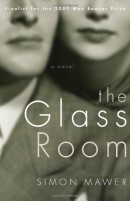 Simon Mawer’s novel, which was shortlisted for the Booker Prize, stars a modernist piece of architecture — the house of the title, which was built in Czechoslovakia for a newlywed couple, a Jew and a gentile, in 1930. Throughout the book, the house remains constant, but its residents change, and Mawer uses the cast to explore six decades of European history. The book was published to raves in the UK, including one by Ian Sansom, who approached it with skepticism:
Simon Mawer’s novel, which was shortlisted for the Booker Prize, stars a modernist piece of architecture — the house of the title, which was built in Czechoslovakia for a newlywed couple, a Jew and a gentile, in 1930. Throughout the book, the house remains constant, but its residents change, and Mawer uses the cast to explore six decades of European history. The book was published to raves in the UK, including one by Ian Sansom, who approached it with skepticism:
The Glass Room is a book about a culture slipping from decadence into catastrophic decline. It’s a study of a marriage. It concerns itself with art, music, architecture, indignity, loneliness, terror, betrayal, sex. And the Holocaust. It should, therefore, be pretentious, unbearable schlock of the most appalling kind. But it’s not. It is, unexpectedly, a thing of extraordinary beauty and symmetry. The Glass Room is a novel of ideas, yet strongly propelled by plot and characterized by an almost dreamlike simplicity of telling.
In the Spectator, Anita Brookner wrote:
It should be emphasized that this is not the sort of house that features in most English novels. There are no echoes of Brideshead here. This house—long, low, rectilinear—does not inspire sentimentality. It is its unfamiliar purity which is its outstanding feature, and this purity also characterizes the novel itself.
The book was published in the U.S. in October to similarly positive reviews, including one by Ron Charles in the Washington Post. Charles writes:
In chapter after chapter, era after era, the house miraculously continues, working as a talisman, “its spirit of transparency percolating the human beings who stand within it, rendering them as translucent as the glass itself.” Like this gorgeous novel, that’s an irresistible promise, though far more troubling than it first appears.
The Glass Room by Simon Mawer
by Simon Mawer
Other press, 416 pp., $14.95
Wednesday, November 25th, 2009
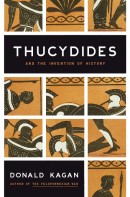 It’s not just any hack who can thoughtfully review a reassessment of Thucydides, the author of The History of the Peloponnesian War. So some big intellectual guns have been hired to consider Donald Kagan’s Thucydides: The Reinvention of History
It’s not just any hack who can thoughtfully review a reassessment of Thucydides, the author of The History of the Peloponnesian War. So some big intellectual guns have been hired to consider Donald Kagan’s Thucydides: The Reinvention of History . Three esteemed critics have praised the book, though the third offers a caveat. At the Barnes & Noble Review, A. C. Grayling writes, “Few historians are in a better position than Donald Kagan to evaluate Thucydides’ merits and achievement,” with which everyone seems to agree. Grayling says the book sets out to “[revise] our view — not of the war but of Thucydides himself; not to impugn him, but to set the record straight by revealing the great historian’s bias and aim, and rescuing those he unfairly attacked.” And his conclusion is a blurb to die for: “Kagan’s book, fascinating and characteristically lucid, is one of those little masterpieces that permanently reconfigure intellectual landscapes. Thucydides will not be the same after this, though neither diminished as a historian nor less significant as a teacher for all time.” In the Wall Street Journal, Peter Stothard argues that while Kagan is “not the first skeptic” about Thucydides, “[he] has produced what reads like the last word on the man.”
. Three esteemed critics have praised the book, though the third offers a caveat. At the Barnes & Noble Review, A. C. Grayling writes, “Few historians are in a better position than Donald Kagan to evaluate Thucydides’ merits and achievement,” with which everyone seems to agree. Grayling says the book sets out to “[revise] our view — not of the war but of Thucydides himself; not to impugn him, but to set the record straight by revealing the great historian’s bias and aim, and rescuing those he unfairly attacked.” And his conclusion is a blurb to die for: “Kagan’s book, fascinating and characteristically lucid, is one of those little masterpieces that permanently reconfigure intellectual landscapes. Thucydides will not be the same after this, though neither diminished as a historian nor less significant as a teacher for all time.” In the Wall Street Journal, Peter Stothard argues that while Kagan is “not the first skeptic” about Thucydides, “[he] has produced what reads like the last word on the man.”
Like Grayling and Stothard, Anthony Grafton, writing at Slate, offers many words of praise. He calls the book “[p]owerfully argued and beautifully written.” But he also notes that, “After 9/11, [Kagan] ardently supported plans for the invasion of Iraq, talking as tough as Alcibiades and disparaging unpatriotic ‘defeatists’ who criticized the invasion or doubted its positive effects.” Combining Kagan’s recent political stances with some key passages from Thucydides that his new book elides, Grafton offers a note of disapproval:
Through the whole fever dream that is human history, no one has ever written more cogently of the disasters of war than this retired general, who saw war as the natural condition of states. No one has ever dissected more meticulously the character of a great democratic state, or revealed more vividly the moral corruption that war brings with it. Of that Thucydides—who was every bit as real as Kagan’s consummately political historian, and who speaks to us every bit as powerfully—the reader will find few traces in this book.
Thucydides: The Reinvention of History by Donald Kagan
by Donald Kagan
Viking, 272 pp., $26.95
Tuesday, November 24th, 2009
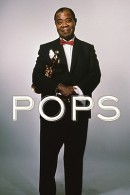 Terry Teachout’s new biography of Louis Armstrong has been quickly met with high praise. In the New York Times, Michiko Kakutani (who named the book one of her ten best of the year) calls it an “eloquent and important” book that “restores this jazzman to his deserved place in the pantheon of American artists.” The Times on the other side of the pond concurs, calling it “terrific.” In that review, Robert Sandall focuses on Armstrong’s complex history with both blacks and whites, the result of struggles and successes in the America of his time. (“By the late 1950s, with his 60th birthday approaching and four decades of solid success behind him, Armstrong was still forced to sleep in a gymnasium while playing in segregated North Carolina and was denied access to a public lavatory in Connecticut.”) The early influence of a Jewish family, the cries of “Uncle Tom” from prominent African-Americans throughout his career, and his disappointment at being “a greater attraction among whites than my own people” were just three of the factors that shaped the man Teachout calls “a child of his time, not ours.” Armstrong’s story is widely known, but Sandall says, “Teachout’s access to a previously unavailable archive of taped conversations and writings has allowed him to construct the most complete picture yet of a well-studied subject.”
Terry Teachout’s new biography of Louis Armstrong has been quickly met with high praise. In the New York Times, Michiko Kakutani (who named the book one of her ten best of the year) calls it an “eloquent and important” book that “restores this jazzman to his deserved place in the pantheon of American artists.” The Times on the other side of the pond concurs, calling it “terrific.” In that review, Robert Sandall focuses on Armstrong’s complex history with both blacks and whites, the result of struggles and successes in the America of his time. (“By the late 1950s, with his 60th birthday approaching and four decades of solid success behind him, Armstrong was still forced to sleep in a gymnasium while playing in segregated North Carolina and was denied access to a public lavatory in Connecticut.”) The early influence of a Jewish family, the cries of “Uncle Tom” from prominent African-Americans throughout his career, and his disappointment at being “a greater attraction among whites than my own people” were just three of the factors that shaped the man Teachout calls “a child of his time, not ours.” Armstrong’s story is widely known, but Sandall says, “Teachout’s access to a previously unavailable archive of taped conversations and writings has allowed him to construct the most complete picture yet of a well-studied subject.”
Pops: A Life of Louis Armstrong by Terry Teachout
by Terry Teachout
Houghton Mifflin, 496 pp., $30.00
Tuesday, November 10th, 2009
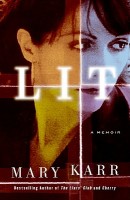 The territory covered in poet Karr’s third memoir — after the mega-seller The Liars’ Club
The territory covered in poet Karr’s third memoir — after the mega-seller The Liars’ Club and its follow-up, Cherry
and its follow-up, Cherry — is summarized by Beth Greenfield in Time Out New York: “Here, she guides us through her college years as an insecure, budding poet, and then into her doomed-from-the-start marriage to a blue-blood writer who refuses, no matter how broke they get, to dip into his family’s wealth. Shortly after they have a son together, Karr descends into serious alcoholism, and the family begins its slow but certain splintering.” Greenfield says Lit is a “testament to [Karr’s] staggering ability to write about her family with range and honesty.” In the Times, Michiko Kakutani offers nearly unqualified praise, even channeling her inner cowgirl (you know she’s in there) to say that Lit “lassos you, hogties your emotions and won’t let you go.” Kakutani isn’t thrilled by sections dealing with Karr’s ex-husband, but judges that otherwise “the book is every bit as absorbing as Ms. Karr’s devastating 1995 memoir, The Liars’ Club, which secured her place on the literary map.”
— is summarized by Beth Greenfield in Time Out New York: “Here, she guides us through her college years as an insecure, budding poet, and then into her doomed-from-the-start marriage to a blue-blood writer who refuses, no matter how broke they get, to dip into his family’s wealth. Shortly after they have a son together, Karr descends into serious alcoholism, and the family begins its slow but certain splintering.” Greenfield says Lit is a “testament to [Karr’s] staggering ability to write about her family with range and honesty.” In the Times, Michiko Kakutani offers nearly unqualified praise, even channeling her inner cowgirl (you know she’s in there) to say that Lit “lassos you, hogties your emotions and won’t let you go.” Kakutani isn’t thrilled by sections dealing with Karr’s ex-husband, but judges that otherwise “the book is every bit as absorbing as Ms. Karr’s devastating 1995 memoir, The Liars’ Club, which secured her place on the literary map.”
At the Barnes & Noble Review, Melissa Pierson directly thanks Karr for her work, and compares the author to a “fine chef.” But she notes disappointment with Karr’s treatment of her religious conversion, saying that “the opportunity [to write about this experience] comes at the cost of the high luster to which she customarily polishes her prose.” Greenfield agrees, writing, “[Karr] is clearly self-conscious about her embracing of religion, [and] she couldn’t quite keep that part of the tale—approximately the last third of the book—from becoming a bit dowdy and plodding.” But the thumbs are mostly up for a memoirist with a strong voice who isn’t simply an exhibitionist. As Kakutani writes, “[Karr’s work] demonstrates that candor and self-revelation only become literature when they are delivered with hard-earned craft, that the exposed life is not the same as the examined one.”
Lit by Mary Karr
by Mary Karr
Harper, 400 pp., $25.99
Thursday, November 5th, 2009
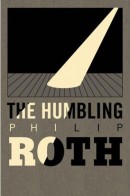 At 140 pages, Roth’s latest is undoubtedly shorter than the combined review coverage it’s already received. And most of those reviews make it sound like the book’s charms end with its terrific cover. Simon Axler is a great actor who, in his 60s, is suddenly gripped by stage fright (“a symptom of age fright, as it were,” quips one critic), which results in a nervous breakdown. Breakdown completed, Axler does what any Roth protagonist would: he seeks sex with a younger woman, this one a disgruntled lesbian.
At 140 pages, Roth’s latest is undoubtedly shorter than the combined review coverage it’s already received. And most of those reviews make it sound like the book’s charms end with its terrific cover. Simon Axler is a great actor who, in his 60s, is suddenly gripped by stage fright (“a symptom of age fright, as it were,” quips one critic), which results in a nervous breakdown. Breakdown completed, Axler does what any Roth protagonist would: he seeks sex with a younger woman, this one a disgruntled lesbian.
Some U.S. papers have adopted a reverential tone. In the L.A. Times, Richard Rayner calls The Humbling “elegant and brutal . . . direct and urgent, a taut and controlled fever-dream that demands to be experienced at a single sitting.” And in the Washington Post, Elaine Showalter says, “[T]he book’s restrained eloquence makes [its] gloomy, over-determined ending convincing and powerful. . . . [Roth’s] ability to inspire, astonish and enrage his readers is undiminished.”
But the majority of the critics express disappointment. In the Boston Globe, Richard Eder is especially put off by the protagonist in “one of Roth’s weakest novels”: “Axler is charmless, an old man of sodden anger and self-pity. Roth has given him no sardonic side trips, no ingenious speculations, no humor. He squats upon his unhappiness like a large bullfrog upon a small lily pad.” It’s William Skidelsky in the Guardian that makes the most convincing and damning case, saying that the novel is “dismayingly poor” by Roth’s standards, and that its plot hinges on a ridiculous, insulting fantasy of an old man turning a lesbian straight.
The Humbling by Philip Roth
by Philip Roth
Houghton Mifflin, 140 pp., $22.00
Wednesday, November 4th, 2009
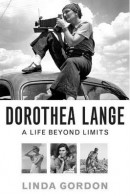 Dorothea Lange’s Depression-era photographs are among the most iconic ever taken. Linda Gordon is a scholar of gender and family at New York University, and her new biography of Lange has been praised, with varying levels of qualification. In the New York Times, David Oshinsky writes a rave, calling the book “absorbing, exhaustively researched” and an “elegant . . . testament to Lange’s gift for challenging her country to open its eyes.” In the New York Review of Books, Jonathan Raban calls it a “substantial, cradle-to-grave biography . . . best at placing [Lange] within the context of the various milieus in which she moved.” But he also thinks that on her academic ground of gender and family, Gordon is “simultaneously confident and not entirely persuasive.” Wendy Smith, in the Los Angeles Times, agrees with this criticism, writing that the book’s “considerable merits almost compensate for Gordon’s irritating tendency to view Lange through a politically correct lens. . . . Given the author’s obvious admiration for her subject, one wishes she had eschewed anachronistic agonizing over such things as ‘the inequality of the transaction’ between the ‘middle-class urbanite’ photographer and her ‘uneducated, often darker-skinned’ subjects, or the hardly astonishing fact that both Lange’s husbands left the housework to her. Applying such contemporary standards detracts from Gordon’s moving, intelligent portrait of an artist who set the standard for every socially concerned photographer who followed.”
Dorothea Lange’s Depression-era photographs are among the most iconic ever taken. Linda Gordon is a scholar of gender and family at New York University, and her new biography of Lange has been praised, with varying levels of qualification. In the New York Times, David Oshinsky writes a rave, calling the book “absorbing, exhaustively researched” and an “elegant . . . testament to Lange’s gift for challenging her country to open its eyes.” In the New York Review of Books, Jonathan Raban calls it a “substantial, cradle-to-grave biography . . . best at placing [Lange] within the context of the various milieus in which she moved.” But he also thinks that on her academic ground of gender and family, Gordon is “simultaneously confident and not entirely persuasive.” Wendy Smith, in the Los Angeles Times, agrees with this criticism, writing that the book’s “considerable merits almost compensate for Gordon’s irritating tendency to view Lange through a politically correct lens. . . . Given the author’s obvious admiration for her subject, one wishes she had eschewed anachronistic agonizing over such things as ‘the inequality of the transaction’ between the ‘middle-class urbanite’ photographer and her ‘uneducated, often darker-skinned’ subjects, or the hardly astonishing fact that both Lange’s husbands left the housework to her. Applying such contemporary standards detracts from Gordon’s moving, intelligent portrait of an artist who set the standard for every socially concerned photographer who followed.”
Dorothea Lange: A Life Beyond Limits by Linda Gordon
by Linda Gordon
Norton, 560 pp., $35.00
Monday, November 2nd, 2009
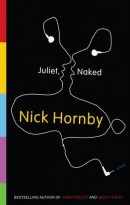 Hornby’s latest obsessive, boyish protagonist is Duncan, 40-something going on fetal. He reveres the music of Tucker Crowe, an American singer-songwriter who suddenly and mysteriously retired and disappeared in 1986. Duncan listens to Crowe’s most famous record, Juliet (a break-up chronicle compared to Dylan’s Blood on the Tracks, Springsteen’s Tunnel of Love, and an unlikely melange of other influences), in two ways: the album as it was officially released and “with the songs placed in the order that Tucker Crowe originally wanted them, according to the sound engineer in charge of the sessions.” The discovery of an acoustic demo version of the album sends a ripple through the Crowe-adoring community and through Duncan’s relationship with Annie, his longtime girlfriend. Annie doesn’t like the demo version — and she learns that Crowe agrees when he gets in touch by e-mail. The well-drawn portrait of a female costar distinguishes Juliet from Hornby’s previous fiction, but the novel also covers familiar territory.
Hornby’s latest obsessive, boyish protagonist is Duncan, 40-something going on fetal. He reveres the music of Tucker Crowe, an American singer-songwriter who suddenly and mysteriously retired and disappeared in 1986. Duncan listens to Crowe’s most famous record, Juliet (a break-up chronicle compared to Dylan’s Blood on the Tracks, Springsteen’s Tunnel of Love, and an unlikely melange of other influences), in two ways: the album as it was officially released and “with the songs placed in the order that Tucker Crowe originally wanted them, according to the sound engineer in charge of the sessions.” The discovery of an acoustic demo version of the album sends a ripple through the Crowe-adoring community and through Duncan’s relationship with Annie, his longtime girlfriend. Annie doesn’t like the demo version — and she learns that Crowe agrees when he gets in touch by e-mail. The well-drawn portrait of a female costar distinguishes Juliet from Hornby’s previous fiction, but the novel also covers familiar territory.
The Wall Street Journal says the novel “will neither win over [Hornby’s] detractors nor disappoint his admirers.” The Independent says, “It is a largely interior novel, of which it might be said that not a lot happens.” The lively interior material is more than enough to propel a reader through the novel, but what happens is disappointing: an early scene where Duncan runs into another loyal, much younger fan outside of Juliet’s house is ridiculous; an ongoing confusion in which Crowe fans believe a photograph of a raging hermit is in fact their hero is unbelievable; and the eventual meeting between Tucker and Duncan leads to some seriously strained dialogue. (I found myself, like Julie Myerson, hoping “that the whole point of Hornby’s novel would be that Tucker Crowe would never actually appear.”)
If Juliet, Naked (or any of Hornby’s novels) was more purely ruminative and less plot-driven — something more like Alain de Botton’s On Love — it would have been improved. Hornby’s personally flavored cultural criticism gets him grief from hipper crowds, but his nonfiction writings about music (Songbook
— it would have been improved. Hornby’s personally flavored cultural criticism gets him grief from hipper crowds, but his nonfiction writings about music (Songbook ), books (his series of columns
), books (his series of columns for The Believer), and soccer (Fever Pitch
for The Believer), and soccer (Fever Pitch ) are a purer distillation of his voice and strengths than can be found in his novels. That said, Juliet, Naked is studded with insight about subjects that seem insight-proof at this late date: cohabitation, technology’s effect on music-listening habits, and prolonged adolescence, among others. (The oddest thing about Hornby is that he’s 52 but more convincingly captures the inner life and concerns of the previous generation than, say, 37-year-old Chuck Klosterman.) As the Independent review puts it, “If [Hornby’s] prose wasn’t so refreshingly transparent and conversational, and his subject matter so seemingly prosaic, the sophistication of his enquiries into human nature would be recognised more often.”
) are a purer distillation of his voice and strengths than can be found in his novels. That said, Juliet, Naked is studded with insight about subjects that seem insight-proof at this late date: cohabitation, technology’s effect on music-listening habits, and prolonged adolescence, among others. (The oddest thing about Hornby is that he’s 52 but more convincingly captures the inner life and concerns of the previous generation than, say, 37-year-old Chuck Klosterman.) As the Independent review puts it, “If [Hornby’s] prose wasn’t so refreshingly transparent and conversational, and his subject matter so seemingly prosaic, the sophistication of his enquiries into human nature would be recognised more often.”
Juliet, Naked by Nick Hornby
by Nick Hornby
Riverhead, 416 pp., $25.95
Monday, October 26th, 2009
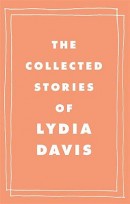 In a positive review, the Los Angeles Times grants that some of Davis’ work can be “willfully emotionless.” There is something stifling to me about her lack of dialogue, and the way her narrators’ inner monologues can come off as the stunted, circular musings of the socially disordered, as in this sentence from the very first story collected here, called “Story”:
In a positive review, the Los Angeles Times grants that some of Davis’ work can be “willfully emotionless.” There is something stifling to me about her lack of dialogue, and the way her narrators’ inner monologues can come off as the stunted, circular musings of the socially disordered, as in this sentence from the very first story collected here, called “Story”:
The fact that he does not tell me the truth all the time makes me not sure of his truth at certain times, and then I work to figure out for myself if what he is telling me is the truth or not, and sometimes I can figure out that it’s not the truth and sometimes I don’t know and never know, and sometimes just because he says it to me over and over again I am convinced it is the truth because I don’t believe he would repeat a lie so often.
And the very short stories peppered throughout are almost never more than semi-clever punch lines or undergraduate-flavored head-scratchers. The entirety of “Example of the Continuing Past Tense in a Hotel Room”:
Your housekeeper has been Shelly.
And the entirety of “Suddenly Afraid”:
because she couldn’t write the name of what she was: a wa wam owm owamn womn
But when on top of her game, Davis can be riveting. The Village Voice says you don’t read her for traditional epiphanies, “You read Lydia Davis to watch a writer patiently divide the space between epiphany and actual human beings by first halves, then quarters, then eighths, and then sixteenths, into infinity.” And that “Davis is more likeable than the forensic technician she’s so often pegged as.”
The Collected Stories of Lydia Davis
Farrar, Straus and Giroux, 752 pages, $30.00
Monday, October 26th, 2009
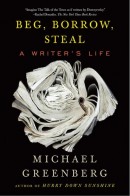 Michael Greenberg is a native New Yorker who was commissioned by London’s Times Literary Supplement to write columns of 1,200 words or so about . . . almost anything. (The editor’s instructions were: “Give it a sense of personal necessity, a sense of urgency. Otherwise, there are no restrictions.”) Beg, Borrow, Steal collects 45 of these pieces, which compose “an autobiography in installments.” We start with Greenberg’s father, the hardworking owner of a scrap-metal yard, who ridiculed his son’s literary ambitions: “Self-conscious about his lack of formal education, he took my bookishness as a personal affront. ‘Which do you think is worth more,’ he once asked me, ‘a commodity or some goddamn idea?’ ” Greenberg also writes of his earliest girlfriends, his children and the many odd jobs he held to try to finance the writing life. (His father gave him a chance to join the family business even after their violent altercations; Greenberg refused.) We’re also taken on wonderful tangents, like a piece about a friend of Greenberg’s son who gets a dream job working as a motorman in the subway. Evocative slides of New York life, these pieces do also add up to one man’s story. And the length constraint, which might sound limiting, is liberating — the pieces have a rare efficiency, packing a lot of plot and insight into small packages.
Michael Greenberg is a native New Yorker who was commissioned by London’s Times Literary Supplement to write columns of 1,200 words or so about . . . almost anything. (The editor’s instructions were: “Give it a sense of personal necessity, a sense of urgency. Otherwise, there are no restrictions.”) Beg, Borrow, Steal collects 45 of these pieces, which compose “an autobiography in installments.” We start with Greenberg’s father, the hardworking owner of a scrap-metal yard, who ridiculed his son’s literary ambitions: “Self-conscious about his lack of formal education, he took my bookishness as a personal affront. ‘Which do you think is worth more,’ he once asked me, ‘a commodity or some goddamn idea?’ ” Greenberg also writes of his earliest girlfriends, his children and the many odd jobs he held to try to finance the writing life. (His father gave him a chance to join the family business even after their violent altercations; Greenberg refused.) We’re also taken on wonderful tangents, like a piece about a friend of Greenberg’s son who gets a dream job working as a motorman in the subway. Evocative slides of New York life, these pieces do also add up to one man’s story. And the length constraint, which might sound limiting, is liberating — the pieces have a rare efficiency, packing a lot of plot and insight into small packages.
Beg, Borrow, Steal by Michael Greenberg
by Michael Greenberg
Other Press, 232 pp., $19.95
Monday, October 26th, 2009
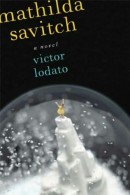 Early in poet and playwright Lodato’s first novel, the titular narrator says, “When I was helping put the dishes in the washer tonight, I broke a plate. I said sorry Ma it slipped. But it didn’t slip, that’s how I am sometimes, and I want to be worse.” Young Mathilda is acting out for several reasons, most notably the recent death of her 16-year-old sister (pushed in front of a train) and her mother’s ensuing grief. In the Washington Post, Carolyn See doesn’t think the novel clears its hurdles: “Unfortunately, when anyone writes about an adolescent, he or she runs the risk of getting caught in Salingeresque echoes, and they inevitably appear here. . . . It’s a hard challenge to write from the lips of an American youngster. Added to that, Mathilda is a notoriously unreliable narrator; you don’t know when to take her word for anything. All this is presented as though it’s wry, even hilarious. But I think it’s terribly sad and depressing. I couldn’t help thinking, to what end?” That critique seems potentially unreliable as well, to my mind: Are Salingeresque echoes inherently bad? And couldn’t contrasting a wry voice with depressing events make for something interesting? But similar notes are struck by other reviewers, including Katherine Powers: “There is a portentous, sacramental quality to events” and “the novel never quite delivers on all this fraughtness.”
Early in poet and playwright Lodato’s first novel, the titular narrator says, “When I was helping put the dishes in the washer tonight, I broke a plate. I said sorry Ma it slipped. But it didn’t slip, that’s how I am sometimes, and I want to be worse.” Young Mathilda is acting out for several reasons, most notably the recent death of her 16-year-old sister (pushed in front of a train) and her mother’s ensuing grief. In the Washington Post, Carolyn See doesn’t think the novel clears its hurdles: “Unfortunately, when anyone writes about an adolescent, he or she runs the risk of getting caught in Salingeresque echoes, and they inevitably appear here. . . . It’s a hard challenge to write from the lips of an American youngster. Added to that, Mathilda is a notoriously unreliable narrator; you don’t know when to take her word for anything. All this is presented as though it’s wry, even hilarious. But I think it’s terribly sad and depressing. I couldn’t help thinking, to what end?” That critique seems potentially unreliable as well, to my mind: Are Salingeresque echoes inherently bad? And couldn’t contrasting a wry voice with depressing events make for something interesting? But similar notes are struck by other reviewers, including Katherine Powers: “There is a portentous, sacramental quality to events” and “the novel never quite delivers on all this fraughtness.”
Mathilda Savitch by Victor Lodato
by Victor Lodato
Farrar, Straus and Giroux, 304 pp., $25.00
Sunday, October 25th, 2009
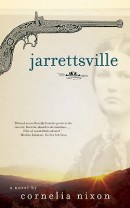 Cornelia Nixon’s new novel, based on real events in her family’s history, begins with a murder. In Civil War-era Maryland, Martha Jane Cairnes, from a Confederate family, murders the man she loves, Nicholas, a union hero. At The Rumpus, Nick Taylor says, “Like all great novelists (historical or otherwise), [Nixon] deals primarily in character, not circumstance—though the historical moment could not have been more perfectly suited to the story.” And though the facts of the case are known early in the book, “With patience reminiscent of Tolstoy, Nixon weaves together a tapestry of events and psychology to explain how an ordinary girl comes to kill her lover, and how she is acquitted by a jury of her peers.” But in the New York Times, Adam Goodheart came away much less impressed. He does credit Nixon with “ably convey[ing] the dark atmosphere of Reconstruction,” but he gets snagged on the smaller details: “Such errors are all the more jarring because the book’s various chapters are written in what purport to be 19th-century voices: those of Nick, Martha and a host of lesser characters. When Nixon has someone hail a friend with ‘Hey, man,’ and another confess, ‘I might have acted more mature,’ it’s as if they were rapid-cycling between 1869 and 1969.”
Cornelia Nixon’s new novel, based on real events in her family’s history, begins with a murder. In Civil War-era Maryland, Martha Jane Cairnes, from a Confederate family, murders the man she loves, Nicholas, a union hero. At The Rumpus, Nick Taylor says, “Like all great novelists (historical or otherwise), [Nixon] deals primarily in character, not circumstance—though the historical moment could not have been more perfectly suited to the story.” And though the facts of the case are known early in the book, “With patience reminiscent of Tolstoy, Nixon weaves together a tapestry of events and psychology to explain how an ordinary girl comes to kill her lover, and how she is acquitted by a jury of her peers.” But in the New York Times, Adam Goodheart came away much less impressed. He does credit Nixon with “ably convey[ing] the dark atmosphere of Reconstruction,” but he gets snagged on the smaller details: “Such errors are all the more jarring because the book’s various chapters are written in what purport to be 19th-century voices: those of Nick, Martha and a host of lesser characters. When Nixon has someone hail a friend with ‘Hey, man,’ and another confess, ‘I might have acted more mature,’ it’s as if they were rapid-cycling between 1869 and 1969.”
Jarrettsville by Cornelia Nixon
by Cornelia Nixon
Counterpoint, 352 pp., $15.95
Thursday, August 6th, 2009
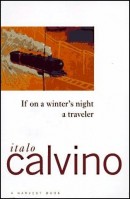 Recommended by Patricia in New York.
Recommended by Patricia in New York.
Funny and masterful, Calvino almost literally mesmerizes you in the first paragraph: “You are about to begin reading Italo Calvino’s new novel, If on a winter’s night a traveler. Relax. Concentrate. Dispel every other thought. Let the world around you fade. Best to close the door; the TV is always on in the next room.” And what follows is a sort of interpretative dance of a novel dramatizing every hot-button issue in literary theory: the integrity of the text; the existence of the author; the knowability of the Other; yadda, yadda, yadda. Two plots are interlaced. One is the story of you, the Reader, pursuing a true copy of Italo Calvino’s new novel, which you’ve discovered is defective; this pursuit is itself a twisting tale of mysterious strangers in train stations, ersatz translations, subversive political movements, and “your” love interest – another reader of the new Italo Calvino novel whose sister is a militant student of “Bothno-Ugaric literatures and languages.” The other plot is the text of the novel in question, and that is where the most beautiful narrative passages occur, although it’s never certain exactly what novel it is, and the stories it tells are never resolved. It’s as if he’s doing a dance on a tightrope; he makes you forget he’s defying gravity as he captivates you with the dance.
Tuesday, May 19th, 2009
 Recommended by Anne in Cleveland.
Recommended by Anne in Cleveland.
One does not usually associate accounts of brutal Nigerian violence with laugh-out-loud funny. Chris Cleave’s Little Bee is both. The front-flap description says the novel should not be summarized, because discovering the plot while you read is integral to the experience, so I will grant that request and keep mum on plot points. I am halfway through, and so I do not know if there is a Crying Game reveal awaiting me. I do know that I have stayed up way too late the past two nights marveling at Cleave’s ability to charm while narrating a series of horrific events set in England and Nigeria. Little Bee is a whole new kind of guilty pleasure.
Tuesday, April 28th, 2009
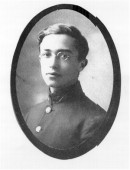 Recommended by Joshua in Brooklyn, New York.
Recommended by Joshua in Brooklyn, New York.
Here is a novel that shuttles between New York City and Los Angeles in the 1930s — some couldn’t ask for anything more — about a recovered and then lost again friendship between two men, one a traveling clothes salesman (the narrator, who gave up writing verse long ago) and the other an editorial assistant to a Hollywood producer (and later unemployed musician whose compositions baffle and worry his only listener, the narrator). Reznikoff (1894-1976) is better known for his poetry — his collected poems, utterly direct and arresting as a rain drop to the scalp, were recently reissued — and those who are familiar with the poems will be enthralled by this record of urban Jewish life, sometimes tough, sometimes sublime, and delivered all the way through in a uniquely decisive though walkabout rhythm. For those who are new to Reznikoff, The Manner Music is as good a place to start as any.
Thursday, April 23rd, 2009
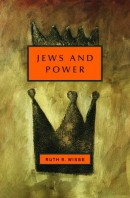 Recommended by Ari in Portland, Oregon.
Recommended by Ari in Portland, Oregon.
As an American Jew, I often feel farther removed from European and Middle Eastern Jews and Judaism than I’d like. My grandparents were born in Eastern Europe, survived the Holocaust, worked the land in a nascent Israel, and then moved to Chicago in the 1950s. I’ve recently been making an effort to better comprehend what it means to be Jewish (perhaps it’s that Jewish guilt) in this day and age, and happened upon Ruth R. Wisse’s excellent book Jews and Power. In just 200 pages, Wisse, a Harvard Professor, discusses the history of the Jews from a political perspective with an understanding and purpose that far eclipses the brevity of the book. I gained more insight into Jewish history, thought, and contemporary politics in this book than I’ve gotten out of much longer books on similar subjects.
Tuesday, April 21st, 2009
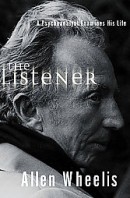 Recommended by Leigh in Cleveland, Ohio.
Recommended by Leigh in Cleveland, Ohio.
At the end of 2007, in the annual The Lives They Lived edition of the New York Times Magazine, I was intrigued by an article that memorialized Allen Wheelis, a psychoanalyst and author who had died that year at the age of 91. I tore the page out, and whenever I happened into a used book store, I looked for his name, determined to buy the first book I found. I kept expecting to find his most well-known work, How People Change (from 1975). Instead, I stumbled on a memoir he wrote in 1999 called The Listener. It is a page-turner. Wheelis, a seasoned psychoanalyst, performs a self-analysis that is both frightfully and endearingly honest. Though far from uplifting, I take comfort that someone so deeply neurotic and just generally pessimistic about life made it through 91 years nonetheless, all the while wrestling with the big questions and doing work he seemed to find important and satisfying. Towards the end of the book, I read this paragraph, remembered it from the Times obit, and was reminded of why I was compelled to look for his work in the first place: “What we deny is not death but the awareness that, before we die, nothing is going to happen. That big vague thing, that redemptive fulfillment, is an illusion, a beckoning bribe to keep us loyal. A symphony has a climax, a poem builds to a burst of meaning, but we are unfinished business. No coming together of strands. The game is called because of darkness.”
(from 1975). Instead, I stumbled on a memoir he wrote in 1999 called The Listener. It is a page-turner. Wheelis, a seasoned psychoanalyst, performs a self-analysis that is both frightfully and endearingly honest. Though far from uplifting, I take comfort that someone so deeply neurotic and just generally pessimistic about life made it through 91 years nonetheless, all the while wrestling with the big questions and doing work he seemed to find important and satisfying. Towards the end of the book, I read this paragraph, remembered it from the Times obit, and was reminded of why I was compelled to look for his work in the first place: “What we deny is not death but the awareness that, before we die, nothing is going to happen. That big vague thing, that redemptive fulfillment, is an illusion, a beckoning bribe to keep us loyal. A symphony has a climax, a poem builds to a burst of meaning, but we are unfinished business. No coming together of strands. The game is called because of darkness.”
Monday, April 20th, 2009
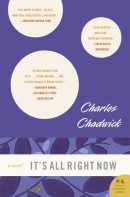 Recommended by Penny in Rockville Centre, New York.
Recommended by Penny in Rockville Centre, New York.
The jacket leaf of this amazing debut novel (by an author who was 72 when it was published) describes beautifully its basic content. It’s about a Brit named Tom Ripple, a “bewildered everyman navigating his way through modern times.” Sounds boring? Not in the least. The author has taken a common life and turned it into a most uncommonly excellent work which, by virtue of its humor, poignancy, and understanding of human foibles, has left a lasting impression on me. It’s a long book at 679 pages, but I didn’t want it to end, the writing is that good. I must say that it’s possible such a reflection on life may well appeal more to those with a longer life experience under their belts.
Friday, April 17th, 2009
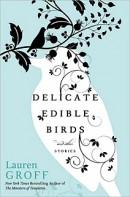 Recommended by Maggie in Detroit, Michigan.
Recommended by Maggie in Detroit, Michigan.
Delicate Edible Birds, a terrific collection of short stories by Lauren Groff, is a book I can comfortably recommend to others, despite being pretty underwhelmed by Groff’s first novel, The Monsters of Templeton. (Of course, I’m a sucker for short stories, birds and impossibly pretty book covers, so I’m sure all those things weigh heavily in this book’s favor.) The nine stories in Groff’s collection are set in wildly different times and locations, but are linked together by motifs of love, sex, violence, crime, and, yes - birds. The female protagonists - many of whom are victimized by the men in their lives - are strong, accomplished women. Groff’s characters are so well formed she makes it look easy, and the stories she builds around them are engrossing, moving, and written with an elegant hand. In short, I may have traded away my copy of The Monsters of Templeton, but Delicate Edible Birds is a keeper. (And not just because it looks gorgeous on my bedside table.)
Wednesday, April 15th, 2009
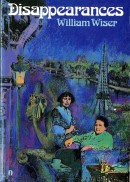 Recommended by Derek in Fayetteville, Arkansas.
Recommended by Derek in Fayetteville, Arkansas.
I’m currently about fifty pages into William Wiser’s Disappearances, so far a comfortingly conventional bildungsroman nestled amidst an inquiry into the “Bluebeard” murders of post-WWI France. Wiser writes with great control, and though he drops pieces of his thorough and precise research into the text with too much flourish, I find the habit endearing and the detail impressive. The procedural bits recall the fourth book of 2666 , but rather unlike that morbid litany, here you get a little relief while Wiser relates the sexual exploits of his fledgling protagonist. Gertrude Stein, whom Wiser supposedly channels with aplomb, hasn’t poked her head out yet, though John Maynard Keynes has surreptitiously fondled the narrator’s knee. I found the novel at random in one of the world’s most wonderful bookstores, Dickson Street Bookshop in Fayetteville. I believe that I was looking to discover a stray Eudora Welty but ended up with this instead, sold on the recommendation of Oakley Hall, who doesn’t say anything of substance but does provide his seal of approval, which is good enough for anybody.
, but rather unlike that morbid litany, here you get a little relief while Wiser relates the sexual exploits of his fledgling protagonist. Gertrude Stein, whom Wiser supposedly channels with aplomb, hasn’t poked her head out yet, though John Maynard Keynes has surreptitiously fondled the narrator’s knee. I found the novel at random in one of the world’s most wonderful bookstores, Dickson Street Bookshop in Fayetteville. I believe that I was looking to discover a stray Eudora Welty but ended up with this instead, sold on the recommendation of Oakley Hall, who doesn’t say anything of substance but does provide his seal of approval, which is good enough for anybody.
Tuesday, April 14th, 2009
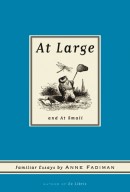 Recommended by Julie in New York City.
Recommended by Julie in New York City.
Anne Fadiman, former editor of The American Scholar, reminds us that the “familiar essay” is a genre worthy of readers’ attention—and even devotion. Falling somewhere between the “critical” and the “personal” essay, the familiar essay is “equal measures heart and brain.” (As Fadiman explains in the preface to her latest essay collection, At Large and At Small, the genre’s heyday was the early nineteenth century. “The familiar essayist didn’t speak to the millions,” she writes. He spoke to one reader, as if the two of them were sitting side by side in front of a crackling fire with a long evening of conversation stretching before them.”) How does Fadiman ignite our interest in this endangered genre? By practicing it so beautifully herself. She writes with characteristic humor and erudition about subjects ranging from coffee and ice cream to the pleasures of letter-writing and being a night owl. You will not regret a single moment in the company of this remarkable writer, whose love for language and life informs and suffuses every one of her charming essays.
 When Martin Stannard’s biography of Muriel Spark was published in the UK last summer, it received mostly positive reviews. The Guardian judged that “Stannard is to be congratulated on producing what will undoubtedly be the standard biography of a writer with perhaps the most distinctive voice — darkly satirical with theological dimensions — in postwar British fiction.” With reservations, the Telegraph concluded, “all in all this is a biography that has been worth the long wait.” And the Independent said, “Stannard is a gifted biographer with a fine turn of phrase. . . . There are a few blind spots . . . but this account will not be surpassed.”
When Martin Stannard’s biography of Muriel Spark was published in the UK last summer, it received mostly positive reviews. The Guardian judged that “Stannard is to be congratulated on producing what will undoubtedly be the standard biography of a writer with perhaps the most distinctive voice — darkly satirical with theological dimensions — in postwar British fiction.” With reservations, the Telegraph concluded, “all in all this is a biography that has been worth the long wait.” And the Independent said, “Stannard is a gifted biographer with a fine turn of phrase. . . . There are a few blind spots . . . but this account will not be surpassed.” by Martin Stannard

 Marlantes, a decorated veteran of the Vietnam War, wrote this novel over the course of 30 years. It follows a company of Marines as they build an outpost on the titular hilltop, abandon it for other duties, and then retake it. Several reviewers of the novel have spent time in the military, or have covered it as journalists. In the New York Times Book Review,
Marlantes, a decorated veteran of the Vietnam War, wrote this novel over the course of 30 years. It follows a company of Marines as they build an outpost on the titular hilltop, abandon it for other duties, and then retake it. Several reviewers of the novel have spent time in the military, or have covered it as journalists. In the New York Times Book Review,  Painter, a professor of American History at Princeton, has written a sprawling book that considers the changing definitions of whiteness from ancient times to the present day.
Painter, a professor of American History at Princeton, has written a sprawling book that considers the changing definitions of whiteness from ancient times to the present day.  When they were killed together in a car accident in December 1940, Nathanael West and Eileen McKenney had been married for eight months. West’s novels,
When they were killed together in a car accident in December 1940, Nathanael West and Eileen McKenney had been married for eight months. West’s novels,  Haslett’s first novel—his 2002 story collection,
Haslett’s first novel—his 2002 story collection,  Next follows a few hours in the life of Kevin Quinn, a middle-aged academic traveling from Ann Arbor to Austin for a job interview. Recent terrorist attacks in Europe have everyone on edge, and Quinn worries about his possible fate while reminiscing about a lost love. Publishers Weekly
Next follows a few hours in the life of Kevin Quinn, a middle-aged academic traveling from Ann Arbor to Austin for a job interview. Recent terrorist attacks in Europe have everyone on edge, and Quinn worries about his possible fate while reminiscing about a lost love. Publishers Weekly  Reviewed by Adam Gallari
Reviewed by Adam Gallari This memoir by Dow, founder of the Texas Innocence Network, details his time as an advocate for those on death row. In the Los Angeles Times,
This memoir by Dow, founder of the Texas Innocence Network, details his time as an advocate for those on death row. In the Los Angeles Times,  In Jerzy Pilch’s novel, beautifully translated from the Polish by Bill Johnston, a writer named Jerzy has been to the “alco ward” 18 times. Each time, he has left with his alcoholism firmly intact. The novel (which takes its name from a bar frequented by Jerzy, as well as a quote from Revelation cited in one chapter: “And I saw another mighty angel come down from heaven, clothed with a cloud . . .”) is a lively, poignant, and often funny examination of a central question: “I’m aware, I really am fully aware that it’s impossible, in my case especially it’s impossible, to live a long and happy life when you drink. But how can you live a long and happy life if you don’t drink?”
In Jerzy Pilch’s novel, beautifully translated from the Polish by Bill Johnston, a writer named Jerzy has been to the “alco ward” 18 times. Each time, he has left with his alcoholism firmly intact. The novel (which takes its name from a bar frequented by Jerzy, as well as a quote from Revelation cited in one chapter: “And I saw another mighty angel come down from heaven, clothed with a cloud . . .”) is a lively, poignant, and often funny examination of a central question: “I’m aware, I really am fully aware that it’s impossible, in my case especially it’s impossible, to live a long and happy life when you drink. But how can you live a long and happy life if you don’t drink?” At Slate,
At Slate, Louise Erdrich’s 13th novel is being called a change of pace, and a good one. Gil, a painter, and Irene, a historian, are married with three children. They each have Native American ancestry, but the narrative here is a tight domestic drama, not the multi-generational sagas Erdrich fans are used to. The couple is miserable, and in hopes of getting Gil to leave, Irene begins a fake diary in which she chronicles manufactured infidelities. In the Washington Post,
Louise Erdrich’s 13th novel is being called a change of pace, and a good one. Gil, a painter, and Irene, a historian, are married with three children. They each have Native American ancestry, but the narrative here is a tight domestic drama, not the multi-generational sagas Erdrich fans are used to. The couple is miserable, and in hopes of getting Gil to leave, Irene begins a fake diary in which she chronicles manufactured infidelities. In the Washington Post,  In Handke’s slim novel, the famous lover hops a wall, fleeing from an angry couple, and begins recounting his life to an innkeeper. In the Los Angeles Times, Natasha Randall notes that more than 1,500 versions of Don Juan’s story have been written, and that most of these “tend to damn Don Juan variously—and to damn the women who succumbed to or partook in the seduction too. But Handke is defiant of these versions, and his Don Juan isn’t corralled into any tidy deliverance.” Instead, Handke “show[s] them up with his clean, broad narration, which refuses to herd a reader toward conclusion. Handke’s text is anti-reductive.”
In Handke’s slim novel, the famous lover hops a wall, fleeing from an angry couple, and begins recounting his life to an innkeeper. In the Los Angeles Times, Natasha Randall notes that more than 1,500 versions of Don Juan’s story have been written, and that most of these “tend to damn Don Juan variously—and to damn the women who succumbed to or partook in the seduction too. But Handke is defiant of these versions, and his Don Juan isn’t corralled into any tidy deliverance.” Instead, Handke “show[s] them up with his clean, broad narration, which refuses to herd a reader toward conclusion. Handke’s text is anti-reductive.” Justin Taylor’s debut story collection has been getting positive reviews—with caveats, but positive. Todd Pruzan, in the New York Times Book Review, offers the least qualified praise, saying, “This spare, sharp book documents a deep authority on the unavoidable confusion of being young, disaffected and human” and that Taylor’s voice is one “that readers—and writers, too—might be seeking out for decades to come.” In Bookforum,
Justin Taylor’s debut story collection has been getting positive reviews—with caveats, but positive. Todd Pruzan, in the New York Times Book Review, offers the least qualified praise, saying, “This spare, sharp book documents a deep authority on the unavoidable confusion of being young, disaffected and human” and that Taylor’s voice is one “that readers—and writers, too—might be seeking out for decades to come.” In Bookforum,  In the 1950s, Henrietta Lacks had cells taken from her cancerous cervix without her knowing. Those cells turned out to be the first to ever grow in culture, and there are “trillions more of [Lacks'] cells growing in laboratories now than there ever were in her body.” Rebecca Skloot’s account of Lacks’ life, as a poor tobacco farmer in Virginia, and her ensuing but anonymous “fame” in the laboratory (her cells known as “HeLa” cells) was 10 years in the making. It’s been getting enough media attention to convince one that maybe books aren’t dying. Any bad karma it may have seems to have landed squarely on its homely cover design. Otherwise, this is one blessed book. The Boston Globe
In the 1950s, Henrietta Lacks had cells taken from her cancerous cervix without her knowing. Those cells turned out to be the first to ever grow in culture, and there are “trillions more of [Lacks'] cells growing in laboratories now than there ever were in her body.” Rebecca Skloot’s account of Lacks’ life, as a poor tobacco farmer in Virginia, and her ensuing but anonymous “fame” in the laboratory (her cells known as “HeLa” cells) was 10 years in the making. It’s been getting enough media attention to convince one that maybe books aren’t dying. Any bad karma it may have seems to have landed squarely on its homely cover design. Otherwise, this is one blessed book. The Boston Globe  Punk pioneer Smith’s memoir recounts her creative and romantic relationship with the controversial photographer Robert Mapplethorpe in 1960s and ’70s New York.
Punk pioneer Smith’s memoir recounts her creative and romantic relationship with the controversial photographer Robert Mapplethorpe in 1960s and ’70s New York. 
 Committed is Gilbert’s follow-up to Eat, Pray, Love, a blockbuster memoir (Julia Roberts will star in the movie) whose
Committed is Gilbert’s follow-up to Eat, Pray, Love, a blockbuster memoir (Julia Roberts will star in the movie) whose  Speaking of enigmatic physicists (see entry immediately below), Paul Dirac, one of the 20th century’s greatest scientists, possessed oddness that matched his brilliance. (Among many other accomplishments, he predicted the existence of antimatter.) Graham Farmelo’s widely praised new biography takes its title from a Niels Bohr quote: “Dirac is the strangest man who ever visited my institute.” In her review of the book for the New York Times, Louisa Gilder
Speaking of enigmatic physicists (see entry immediately below), Paul Dirac, one of the 20th century’s greatest scientists, possessed oddness that matched his brilliance. (Among many other accomplishments, he predicted the existence of antimatter.) Graham Farmelo’s widely praised new biography takes its title from a Niels Bohr quote: “Dirac is the strangest man who ever visited my institute.” In her review of the book for the New York Times, Louisa Gilder  In naming João Magueijo’s A Brilliant Darkness one of the best science books of 2009,
In naming João Magueijo’s A Brilliant Darkness one of the best science books of 2009,  Jane Gardam, 81, has had a long and successful literary career, full of prizes, in the UK, but she only came to wide attention in the U.S. with the 2006 publication of
Jane Gardam, 81, has had a long and successful literary career, full of prizes, in the UK, but she only came to wide attention in the U.S. with the 2006 publication of  Simon Mawer’s novel, which was shortlisted for the Booker Prize, stars a modernist piece of architecture — the house of the title, which was built in Czechoslovakia for a newlywed couple, a Jew and a gentile, in 1930. Throughout the book, the house remains constant, but its residents change, and Mawer uses the cast to explore six decades of European history. The book was published to raves in the UK, including
Simon Mawer’s novel, which was shortlisted for the Booker Prize, stars a modernist piece of architecture — the house of the title, which was built in Czechoslovakia for a newlywed couple, a Jew and a gentile, in 1930. Throughout the book, the house remains constant, but its residents change, and Mawer uses the cast to explore six decades of European history. The book was published to raves in the UK, including  It’s not just any hack who can thoughtfully review a reassessment of Thucydides, the author of The History of the Peloponnesian War. So some big intellectual guns have been hired to consider Donald Kagan’s
It’s not just any hack who can thoughtfully review a reassessment of Thucydides, the author of The History of the Peloponnesian War. So some big intellectual guns have been hired to consider Donald Kagan’s  Terry Teachout’s new biography of Louis Armstrong has been quickly met with high praise. In the New York Times, Michiko Kakutani (who named the book one of her ten best of the year)
Terry Teachout’s new biography of Louis Armstrong has been quickly met with high praise. In the New York Times, Michiko Kakutani (who named the book one of her ten best of the year)  The territory covered in poet Karr’s third memoir — after the mega-seller
The territory covered in poet Karr’s third memoir — after the mega-seller  At 140 pages, Roth’s latest is undoubtedly shorter than the combined review coverage it’s already received. And most of those reviews make it sound like the book’s charms end with its terrific cover. Simon Axler is a great actor who, in his 60s, is suddenly gripped by stage fright (“a symptom of age fright, as it were,”
At 140 pages, Roth’s latest is undoubtedly shorter than the combined review coverage it’s already received. And most of those reviews make it sound like the book’s charms end with its terrific cover. Simon Axler is a great actor who, in his 60s, is suddenly gripped by stage fright (“a symptom of age fright, as it were,”  Dorothea Lange’s Depression-era photographs are among the most iconic ever taken. Linda Gordon is a scholar of gender and family at New York University, and her new biography of Lange has been praised, with varying levels of qualification. In the New York Times,
Dorothea Lange’s Depression-era photographs are among the most iconic ever taken. Linda Gordon is a scholar of gender and family at New York University, and her new biography of Lange has been praised, with varying levels of qualification. In the New York Times,  Hornby’s latest obsessive, boyish protagonist is Duncan, 40-something going on fetal. He reveres the music of Tucker Crowe, an American singer-songwriter who suddenly and mysteriously retired and disappeared in 1986. Duncan listens to Crowe’s most famous record, Juliet (a break-up chronicle compared to Dylan’s Blood on the Tracks, Springsteen’s Tunnel of Love, and an unlikely melange of other influences), in two ways: the album as it was officially released and “with the songs placed in the order that Tucker Crowe originally wanted them, according to the sound engineer in charge of the sessions.” The discovery of an acoustic demo version of the album sends a ripple through the Crowe-adoring community and through Duncan’s relationship with Annie, his longtime girlfriend. Annie doesn’t like the demo version — and she learns that Crowe agrees when he gets in touch by e-mail. The well-drawn portrait of a female costar distinguishes Juliet from Hornby’s previous fiction, but the novel also covers familiar territory.
Hornby’s latest obsessive, boyish protagonist is Duncan, 40-something going on fetal. He reveres the music of Tucker Crowe, an American singer-songwriter who suddenly and mysteriously retired and disappeared in 1986. Duncan listens to Crowe’s most famous record, Juliet (a break-up chronicle compared to Dylan’s Blood on the Tracks, Springsteen’s Tunnel of Love, and an unlikely melange of other influences), in two ways: the album as it was officially released and “with the songs placed in the order that Tucker Crowe originally wanted them, according to the sound engineer in charge of the sessions.” The discovery of an acoustic demo version of the album sends a ripple through the Crowe-adoring community and through Duncan’s relationship with Annie, his longtime girlfriend. Annie doesn’t like the demo version — and she learns that Crowe agrees when he gets in touch by e-mail. The well-drawn portrait of a female costar distinguishes Juliet from Hornby’s previous fiction, but the novel also covers familiar territory. In a positive review, the Los Angeles Times
In a positive review, the Los Angeles Times  Michael Greenberg is a native New Yorker who was commissioned by London’s Times Literary Supplement to write columns of 1,200 words or so about . . . almost anything. (The editor’s instructions were: “Give it a sense of personal necessity, a sense of urgency. Otherwise, there are no restrictions.”) Beg, Borrow, Steal collects 45 of these pieces, which compose “an autobiography in installments.” We start with Greenberg’s father, the hardworking owner of a scrap-metal yard, who ridiculed his son’s literary ambitions: “Self-conscious about his lack of formal education, he took my bookishness as a personal affront. ‘Which do you think is worth more,’ he once asked me, ‘a commodity or some goddamn idea?’ ” Greenberg also writes of his earliest girlfriends, his children and the many odd jobs he held to try to finance the writing life. (His father gave him a chance to join the family business even after their violent altercations; Greenberg refused.) We’re also taken on wonderful tangents, like a piece about a friend of Greenberg’s son who gets a dream job working as a motorman in the subway. Evocative slides of New York life, these pieces do also add up to one man’s story. And the length constraint, which might sound limiting, is liberating — the pieces have a rare efficiency, packing a lot of plot and insight into small packages.
Michael Greenberg is a native New Yorker who was commissioned by London’s Times Literary Supplement to write columns of 1,200 words or so about . . . almost anything. (The editor’s instructions were: “Give it a sense of personal necessity, a sense of urgency. Otherwise, there are no restrictions.”) Beg, Borrow, Steal collects 45 of these pieces, which compose “an autobiography in installments.” We start with Greenberg’s father, the hardworking owner of a scrap-metal yard, who ridiculed his son’s literary ambitions: “Self-conscious about his lack of formal education, he took my bookishness as a personal affront. ‘Which do you think is worth more,’ he once asked me, ‘a commodity or some goddamn idea?’ ” Greenberg also writes of his earliest girlfriends, his children and the many odd jobs he held to try to finance the writing life. (His father gave him a chance to join the family business even after their violent altercations; Greenberg refused.) We’re also taken on wonderful tangents, like a piece about a friend of Greenberg’s son who gets a dream job working as a motorman in the subway. Evocative slides of New York life, these pieces do also add up to one man’s story. And the length constraint, which might sound limiting, is liberating — the pieces have a rare efficiency, packing a lot of plot and insight into small packages. Early in poet and playwright Lodato’s first novel, the titular narrator says, “When I was helping put the dishes in the washer tonight, I broke a plate. I said sorry Ma it slipped. But it didn’t slip, that’s how I am sometimes, and I want to be worse.” Young Mathilda is acting out for several reasons, most notably the recent death of her 16-year-old sister (pushed in front of a train) and her mother’s ensuing grief. In the Washington Post, Carolyn See
Early in poet and playwright Lodato’s first novel, the titular narrator says, “When I was helping put the dishes in the washer tonight, I broke a plate. I said sorry Ma it slipped. But it didn’t slip, that’s how I am sometimes, and I want to be worse.” Young Mathilda is acting out for several reasons, most notably the recent death of her 16-year-old sister (pushed in front of a train) and her mother’s ensuing grief. In the Washington Post, Carolyn See  Cornelia Nixon’s new novel, based on real events in her family’s history, begins with a murder. In Civil War-era Maryland, Martha Jane Cairnes, from a Confederate family, murders the man she loves, Nicholas, a union hero. At The Rumpus,
Cornelia Nixon’s new novel, based on real events in her family’s history, begins with a murder. In Civil War-era Maryland, Martha Jane Cairnes, from a Confederate family, murders the man she loves, Nicholas, a union hero. At The Rumpus,  Recommended by Patricia in New York.
Recommended by Patricia in New York. Recommended by Anne in Cleveland.
Recommended by Anne in Cleveland. Recommended by Joshua in Brooklyn, New York.
Recommended by Joshua in Brooklyn, New York. Recommended by Ari in Portland, Oregon.
Recommended by Ari in Portland, Oregon. Recommended by Leigh in Cleveland, Ohio.
Recommended by Leigh in Cleveland, Ohio. Recommended by Penny in Rockville Centre, New York.
Recommended by Penny in Rockville Centre, New York. Recommended by Maggie in Detroit, Michigan.
Recommended by Maggie in Detroit, Michigan. Recommended by Derek in Fayetteville, Arkansas.
Recommended by Derek in Fayetteville, Arkansas. Recommended by Julie in New York City.
Recommended by Julie in New York City.